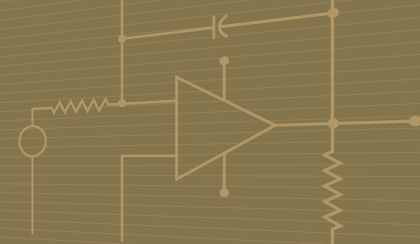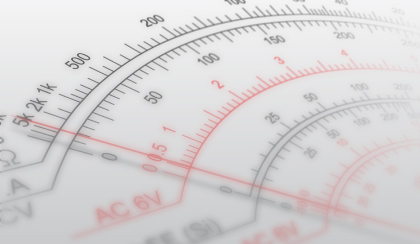933uweeViewNews Object
(
[_rendered:protected] => 1
[_classes:protected] => Array
(
[0] => view-block
[1] => block--spotlight-robust-news
)
[_finalHTML:protected] => https://hedy2024.ece.uw.edu/spotlight/mingfei-chen-2025-google-phd-fellowship-2/

UW ECE doctoral student Mingfei Chen has been awarded a 2025 Google PhD Fellowship in Machine Perception. This award is one of the most competitive honors for doctoral students in artificial intelligence research today.
https://hedy2024.ece.uw.edu/spotlight/maryam-fazel-2025-farkas-prize/

UW ECE Professor Maryam Fazel received the award for her foundational work in the field of optimization and for pioneering contributions to data science and artificial intelligence.
https://hedy2024.ece.uw.edu/spotlight/uw-ece-efp-2026-26-fellows/

This new program supports transfer of research into commercial products through prototyping, customer discovery, and market analysis. Learn how UW ECE-EFP fellows are translating their ideas into impact.
https://hedy2024.ece.uw.edu/spotlight/uw-ece-is-hiring-4/

UW ECE is inviting applications for tenure-track assistant professor positions.
https://hedy2024.ece.uw.edu/spotlight/irene-peden-in-memoriam/
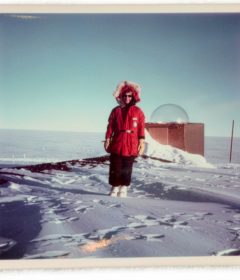
UW ECE Professor Emerita Irene Peden passed away on August 22, 2025, just a few weeks before her 100th birthday. She was an exceptional researcher and educator who created pathways to success for women in engineering throughout her career.
https://hedy2024.ece.uw.edu/spotlight/ifds-workshop-brings-together-experts-to-help-make-ai-more-reliable-robust-and-trustworthy/
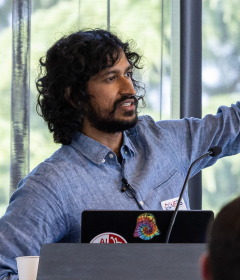
The Institute for Foundations of Data Science brought AI and machine learning experts together from across the nation to explore the mathematical, statistical, and algorithmic underpinnings of modern AI systems — advancing theory to better understand and improve AI technology.
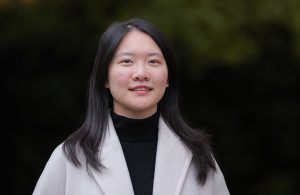 UW ECE doctoral student Mingfei Chen has received a 2025 Google PhD Fellowship in Machine Perception. This award supports Chen’s pioneering work developing AI systems capable of perceiving and understanding three-dimensional spaces — a capability that could transform robotics, augmented reality, and assistive technologies. Photo by Ryan Hoover / UW ECE[/caption]
UW ECE doctoral student Mingfei Chen was recently awarded a 2025 Google PhD Fellowship in Machine Perception. This award is one of the most competitive honors for doctoral students in artificial intelligence research today. Google.org awarded this fellowship to Chen to support her work developing AI systems that can sense and comprehend three-dimensional spaces. In late October, Google announced the fellowship recipients in its official blog, The Keyword.
The Google PhD Fellowship Program, now in its 16th year, supports outstanding graduate students who are conducting exceptional and innovative research in computer science and related fields, specifically focusing on candidates who seek to influence the future of technology. The Program provides vital direct financial support for its recipients’ doctoral degree pursuits and connects each Fellow with a dedicated Google Research Mentor, reinforcing the company’s commitment to nurturing the academic community.
UW ECE doctoral student Mingfei Chen has received a 2025 Google PhD Fellowship in Machine Perception. This award supports Chen’s pioneering work developing AI systems capable of perceiving and understanding three-dimensional spaces — a capability that could transform robotics, augmented reality, and assistive technologies. Photo by Ryan Hoover / UW ECE[/caption]
UW ECE doctoral student Mingfei Chen was recently awarded a 2025 Google PhD Fellowship in Machine Perception. This award is one of the most competitive honors for doctoral students in artificial intelligence research today. Google.org awarded this fellowship to Chen to support her work developing AI systems that can sense and comprehend three-dimensional spaces. In late October, Google announced the fellowship recipients in its official blog, The Keyword.
The Google PhD Fellowship Program, now in its 16th year, supports outstanding graduate students who are conducting exceptional and innovative research in computer science and related fields, specifically focusing on candidates who seek to influence the future of technology. The Program provides vital direct financial support for its recipients’ doctoral degree pursuits and connects each Fellow with a dedicated Google Research Mentor, reinforcing the company’s commitment to nurturing the academic community.
Chen’s research: Spatially aware AI
Chen, a third-year doctoral student in the UW NeuroAI Lab, which is directed by her adviser, UW ECE Associate Professor Eli Shlizerman, is developing spatially aware multimodal AI systems that are trustworthy, safe, and human-centered. Her research focuses on enabling AI to perceive and understand three-dimensional spaces — a capability that could transform robotics, augmented reality, and assistive technologies.
"I am very excited about building AI systems that can truly perceive the world — not just through vision and language, but through spatial awareness and more modalities." — UW ECE doctoral student Mingfei Chen
“Barely a few years into her doctoral research, Mingfei has already built cutting-edge deep learning models that combine sound and vision to create detailed representations of 3D scenes — both real and virtual,” Shlizerman said. “Now, Mingfei is daring to take this even further. She is exploring how machines equipped with deep learning can understand the scenes they perceive. It’s an exciting and bold direction, and the Google PhD Fellowship will empower Mingfei to make it a reality.”
Real-world applications
[caption id="attachment_39441" align="alignright" width="450"] Google.org is providing over $10 million to support 255 doctoral students like Chen across 35 countries and 12 research domains, committing to a new generation of researchers who understand that accelerating scientific discovery is vital to solving the world’s toughest challenges.[/caption]
Like humans, spatially aware multimodal AI systems use sensing modalities, such as vision, sound, and motion, to build contextual awareness and an understanding of a three-dimensional space. These AI systems also use other modes, such as language and geometry, to enrich their understanding. This technology could help to make the world more accessible and supportive for people, especially for those with disabilities or limited mobility. Potential applications include:
Google.org is providing over $10 million to support 255 doctoral students like Chen across 35 countries and 12 research domains, committing to a new generation of researchers who understand that accelerating scientific discovery is vital to solving the world’s toughest challenges.[/caption]
Like humans, spatially aware multimodal AI systems use sensing modalities, such as vision, sound, and motion, to build contextual awareness and an understanding of a three-dimensional space. These AI systems also use other modes, such as language and geometry, to enrich their understanding. This technology could help to make the world more accessible and supportive for people, especially for those with disabilities or limited mobility. Potential applications include:
- Spatial memory assistants: AI-equipped eyeglasses could help a person remember where they placed their keys or track how a room changes over time — using vision, sound, and spatial cues to retrieve useful information from the environment.
- Safety in dynamic environments: Wearable devices could detect approaching vehicles or obstacles outside a person’s field of view and provide directional audio alerts.
- Interactive spatial guidance: AI assistants could help people navigate complex environments by aligning audio cues with visual context. For example, when an assistant says “the object on your left,” the sound could originate from the user’s left side, linking language, vision, and spatial geometry. In public spaces like museums, these assistants could fuse real-time visual recognition with spatial audio to direct visitors toward exhibits and deliver information hands-free, enabling intuitive navigation without relying solely on sight.
- Immersive virtual re-experiencing: Spatially aware multimodal AI systems could recreate real environments for virtual tourism or memory replay. Instead of viewing static images or videos, users could “re-live” dynamic scenes (for example, standing near a landmark like the Eiffel Tower) with spatial audio and 3D geometry that deliver a natural, embodied experience.
Empowering STEM education
Chen is also passionate about contributing to STEM education and entrepreneurship. For the past two years, she has served as lead teaching assistant for UW ECE’s
Engineering Innovation and Entrepreneurship (ENGINE) capstone program, mentoring over 100 students and coordinating a team of eight teaching assistants. Through ENGINE, Chen has helped foster interdisciplinary collaboration on real-world engineering projects with leading technology companies. She said she is excited to contribute to similar projects in the future through the University as well as through global collaboration opportunities, such as those the Google PhD Fellowship might provide.
Looking ahead
Chen said that this fellowship gives her freedom to pursue unconventional and challenging research directions without being constrained by short-term trends in the field. She is looking forward to collaborating with Google researchers and continuing to build AI systems that enhance productivity, autonomy, and quality of life.
“I am very excited about building AI systems that can truly perceive the world — not just through vision and language, but through spatial awareness and more modalities,” Chen said. “Humans intuitively combine sight, sound, and context to understand the three-dimensional world around us. Pursuing this direction could unlock a deeper form of perception for AI — crucial for future technologies like smart glasses, spatial assistants, and personal robots.”
For more information about Mingfei Chen and her research, visit the UW NeuroAI Lab website.
[post_title] => UW ECE graduate student Mingfei Chen receives 2025 Google PhD Fellowship for pioneering AI research
[post_excerpt] =>
[post_status] => publish
[comment_status] => closed
[ping_status] => closed
[post_password] =>
[post_name] => mingfei-chen-2025-google-phd-fellowship-2
[to_ping] =>
[pinged] =>
[post_modified] => 2025-12-09 13:02:40
[post_modified_gmt] => 2025-12-09 21:02:40
[post_content_filtered] =>
[post_parent] => 0
[guid] => https://www.ece.uw.edu/?post_type=spotlight&p=39425
[menu_order] => 1
[post_type] => spotlight
[post_mime_type] =>
[comment_count] => 0
[filter] => raw
)
[1] => WP_Post Object
(
[ID] => 39282
[post_author] => 27
[post_date] => 2025-12-02 10:00:03
[post_date_gmt] => 2025-12-02 18:00:03
[post_content] => [caption id="attachment_39302" align="alignright" width="475"]
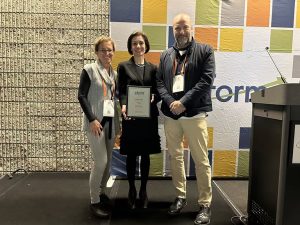
UW ECE Professor Maryam Fazel receives the 2025 Farkas Prize from the INFORMS Optimization Society. The award was presented on October 26 at the INFORMS Annual Meeting in Atlanta, Georgia, by Katya Scheinberg (left), Coca-Cola Foundation Chair and Professor in the H. Milton Stewart School of Industrial and Systems Engineering at Georgia Tech, and Andrea Lodi (right), the Andrew H. and Ann R. Tisch Professor of operations research and information engineering at Cornell University.[/caption]
The University of Washington Department of Electrical & Computer Engineering congratulates Professor
Maryam Fazel, recipient of the
2025 Farkas Prize from the Institute for Operations Research and the Management Sciences, or INFORMS, Optimization Society. She accepted the award in late October during the INFORMS Annual Meeting in Atlanta, Georgia.
The Farkas Prize is an annual award honoring a mid-career researcher for outstanding, career-spanning contributions to the field of optimization — a discipline that develops mathematical models and algorithms to improve decision making, advance engineering design, and provide the computational foundation for machine learning systems.
Fazel was recognized for her foundational work in optimization and her pioneering contributions to data science and artificial intelligence. The award was presented on Sunday, October 26, at the
INFORMS Annual Meeting in Atlanta, Georgia.
“I’m deeply honored to receive the Farkas Prize. Optimization has been a central theme in my research, and it’s exciting to see its growing impact on fields like data science and artificial intelligence,” Fazel said. “This recognition reflects the incredible collaborations I’ve had with students, postdoctoral scholars, and colleagues over the years, and I look forward to continuing to explore new challenges in this area.”
Fazel holds the
Moorthy Family Inspiration Career Development Professorship and serves as director of the
Institute for Foundations of Data Science at the UW. INFORMS promotes the development and application of data optimization methods and software tools to solve complex problems in operations research and management science.
Learn more about the Farkas Prize on the INFORMS website.
[post_title] => UW ECE Professor Maryam Fazel receives 2025 Farkas Prize
[post_excerpt] =>
[post_status] => publish
[comment_status] => closed
[ping_status] => closed
[post_password] =>
[post_name] => maryam-fazel-2025-farkas-prize
[to_ping] =>
[pinged] =>
[post_modified] => 2025-12-02 10:50:53
[post_modified_gmt] => 2025-12-02 18:50:53
[post_content_filtered] =>
[post_parent] => 0
[guid] => https://www.ece.uw.edu/?post_type=spotlight&p=39282
[menu_order] => 2
[post_type] => spotlight
[post_mime_type] =>
[comment_count] => 0
[filter] => raw
)
[2] => WP_Post Object
(
[ID] => 39169
[post_author] => 27
[post_date] => 2025-11-12 09:12:55
[post_date_gmt] => 2025-11-12 17:12:55
[post_content] =>
Article by Wayne Gillam, Photos by Ryan Hoover /
UW ECE News
[caption id="attachment_39171" align="alignright" width="550"]
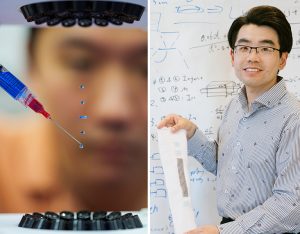
The new UW ECE Entrepreneurial Fellows Program, or UW ECE-EFP, helps translate research into real-world impact. On the left, UW ECE-EFP fellow Jared Nakahara adds droplets into an acoustic levitation prototype he created with his adviser, UW ECE and Allen School Professor Joshua Smith. Together, they co-founded Levity, a startup building acoustic levitators for lab automation. On the right, UW ECE-EFP fellow Sen Zhang holds MultiSensKnit, a sensor-packed knitted sleeve designed for rehabilitation assessment. Zhang created and developed MultiSensKnit with UW ECE Assistant Professor Yiyue Luo.[/caption]
According to the UW’s innovation hub,
CoMotion, UW ECE consistently ranks among the University’s leading generators of startup companies. The Department has maintained this distinction for decades, alongside its strong academic reputation and longstanding history of supporting entrepreneurship. But UW ECE isn’t resting on that legacy. In early 2025, the Department created a new program aimed at fostering and developing entrepreneurs.
The new
UW ECE Entrepreneurial Fellows Program, or UW ECE-EFP, is funded exclusively by royalties earned on UW ECE innovations. The Program is designed to support the transfer of research advances into commercialized impact through prototyping, customer discovery, and market analysis.
“This new program enables fellowship recipients to leverage the richness of the entrepreneurial spirit that’s within UW ECE, the UW College of Engineering, and the broader University,” said UW ECE Career and Industry Programs Manager
Rebecca Carlson, who facilitates the UW ECE-EFP. “There is a wide variety of instructors and professors here who have started companies, staff and Department affiliates with industry experience, and an alumni network that can help support our fellows in their entrepreneurial endeavors.”
“Innovation starts here because our Department is a place where ideas are born and developed in a serious way.”
— UW ECE Professor and Chair Eric Klavins
Fellowship recipients receive a postdoctoral scholar salary and benefits for one year, partial salary support for their faculty adviser, mentorship from the University's network of industry experts and entrepreneurs, and support for travel and expenses. UW ECE also partners with the CoMotion
Postdoctoral Entrepreneurship Program to provide fellowship recipients with access to an entrepreneurial cohort and a strong support network. This close partnership with CoMotion helps fellows move their research out of the lab and into the marketplace. Current UW ECE doctoral students and postdoctoral scholars as well as those eligible for a postdoctoral scholar position in the Department can apply to the UW ECE-EFP.
“Innovation starts here because our Department is a place where ideas are born and developed in a serious way,” said UW ECE Professor and Chair
Eric Klavins. “When we promote entrepreneurship through programs like this, it highlights one of the many ways universities benefit our greater society — serving as a supportive place where people can turn their dreams into reality.”
Read on to learn about the inaugural 2025–26 UW ECE-EFP fellows and how, with the help of this new program, they are each realizing their own vision for the future by turning their research projects into commercial ventures.
Jared Nakahara — Levity
[caption id="attachment_39175" align="alignright" width="550"]
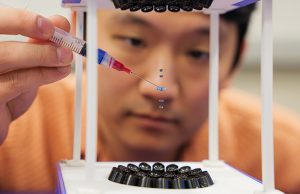
Levity builds acoustic levitators for automated, contamination-free experiments requiring precise control. The prototype shown above, operated by Nakahara, uses ultrasonic sound waves — well above the threshold of human hearing — to suspend and manipulate droplets and small objects in midair without physical contact.[/caption]
Born and raised in the Seattle area, Jared Nakahara first became interested in engineering when he was in high school, during a summer program at the
DigiPen Institute of Technology, a video game and arts college located in Redmond, Washington. The program was provided by the
Washington Network for Innovative Careers, and it gave Nakahara his first exposure to robotics, coding, and mechatronics — technology combining mechanical engineering and electronics. Talented in sports and contemplating a career in baseball, Nakahara was inspired by the WANIC program to have a change of heart. He moved his focus from baseball to engineering. Both of Nakahara’s parents were engineers, and being familiar with the field, they encouraged this new direction for their son.
The WANIC summer program sparked what became for Nakahara a passionate interest in electrical and computer engineering. He decided to pursue engineering as a career, and he returned to DigiPen in subsequent years to teach engineering topics to pre-college students. Nakahara chose to study engineering at UW ECE, and he took his education all the way, earning his bachelor’s, master’s, and doctoral degrees in electrical engineering in 2018, 2021, and 2025, respectively.
As a UW ECE undergraduate, Nakahara was initially interested in quantum computing technologies, but after taking a course on field-programmable gate arrays, or FPGAs, taught by UW ECE and Allen School Professor
Joshua Smith, his interest shifted to neural engineering. Smith, who is a research leader in the
Center for Neurotechnology, was building implantable neural interfaces for spinal cord rehabilitation. The topic fascinated Nakahara. So much so, he joined Smith’s
Sensor Systems Laboratory, and when he started graduate school, Smith became his faculty adviser. Today, Nakahara is a postdoctoral scholar in Smith’s lab.
“I think the programmable laboratory space is interesting because we can potentially help to build life-saving pharmaceuticals, treatments for cancer, and personalized medicine as well as other new pharmaceuticals that could be coming to market.”
— Jared Nakahara, UW ECE postdoctoral scholar and 2025–26 UW ECE-EFP fellow
When Nakahara was a graduate student, he and Smith were inspired by
transcranial magnetic stimulation, a treatment used for neural disorders, such as depression. With this in mind, they began investigating ways to use
acoustic levitation technology to build a non-invasive stimulator for neurons. Acoustic levitation uses high-frequency sound waves (ultrasound) to suspend and move matter in liquids or gas, overcoming gravity. Around this same time, Nakahara developed an interest in robotic manipulation. He built and experimented with different acoustic levitation systems, aiming to develop a tool that could augment the capabilities of general-purpose robots, giving these robots improved manipulation precision and the ability to handle small or fragile objects without making physical contact.
“Bringing the acoustic levitator into the robotic sphere became a fascinating thing for me because I could do it very quickly, innovating on the controls as well as the hardware and software stack,” Nakahara said. “Once I went down that rabbit hole, it evolved into a much bigger thing when I realized our acoustic levitator could be used as a robotic manipulation platform.”
Through discussions with Smith, Nakahara realized that the acoustic levitator they were developing could be beneficial for laboratory experiments in bioengineering and materials science that needed to be automated, contamination-free, and executed with precision. With Smith’s support, Nakahara switched his research focus from neural engineering to acoustic levitation systems. Now, he and Smith are in the early stages of co-founding
Levity, a startup company dedicated to building acoustic levitators for laboratory automation.
An acoustic levitation system for next-generation laboratory automation
[caption id="attachment_39177" align="alignright" width="550"]
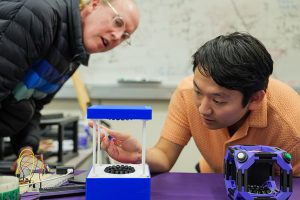
Levity’s tabletop acoustic levitation system is quick to set up and operate, and it can even run remotely. Nakahara demonstrates the prototype while Smith observes — showing how easy this device is to use.[/caption]
What Levity’s acoustic levitation system does could seem like science fiction. The device uses high-frequency sound, well above the threshold of human hearing, to levitate, contain, and manipulate liquids and small objects in midair — all without touching the levitated material. This levitator is a completely enclosed tabletop system that can contain filtered air or inert gases useful for laboratory experimentation, such as helium, or argon. The sound waves it generates create three-dimensional traps, pockets of sound pressure, which provide a contactless, contamination-free way of containing, manipulating, and examining liquids, solids, and living organisms. Because it uses ultrasound, the device is inaudible to humans and safe for people to use as well as for any living organism the device might contain.
“One of the nice things our acoustic levitator can do is lift, manipulate, and contain living organisms without harming them,” Nakahara said. “You can put a living ant or mosquito into this device and examine it with a camera. You can look at the entire specimen while it’s alive, do species identification, and extract much more information than you could from a more conventional platform.”
The advantages of Nakahara and Smith’s levitator as compared to other laboratory automation systems are many. Because it is a completely enclosed, contactless system, it provides an encapsulated environment for experiments. It is capable of mixing liquids and manipulating levitated objects ranging from millimeters to nanometers in diameter— all without touching or contaminating the experimental material. It also can be programmed to automate the manipulation and data collection tasks of laboratory experiments, removing typical and often costly human errors that happen when people pipette liquids and handle materials. The device enables the user to view the reaction progress of their experiment from start to finish as well as examine it in great detail with cameras, spectrometers, or other sensors. This complete encapsulation and tight integration of the experimental procedure allows researchers to gather much more reliable data than what would otherwise be possible when using multiple pieces of equipment. And as a high-precision scientific instrument, this acoustic levitation system can measure the mass of levitated matter down to a nanogram without touching it.
In addition, Levity’s acoustic levitation system is a tabletop device that is easy to set up and use, and it can be run remotely offsite. Nakahara said that accessible, remote operation could open up a world of possibilities for users. For example, the levitator could be set up in underserved or hard-to-reach areas to run fast and accurate on-site tests for diseases. Or researchers could automate and run their experiments from outside the lab, enabling them to do other things while saving time and money. Or several of these acoustic levitators working together could be set up to operate much like a computer server farm does today — providing automated laboratory services for many different users, all from one, compact location.
Levity’s acoustic levitation system could appeal to researchers working in many different types of scientific applications. But for now, Nakahara said he sees Levity’s primary market being researchers who need liquid handling systems for DNA, proteins, and microscopic materials as part of their workflow, for example, when scientists are developing pharmaceuticals or medical diagnostics.
“I think the programmable laboratory space is interesting because we can potentially help to build life-saving pharmaceuticals, treatments for cancer, and personalized medicine as well as other new pharmaceuticals that could be coming to market,” Nakahara said. “If we can help doctors as well as the health-care industry provide faster diagnoses and better treatments, then that’s something of great benefit to everybody.”
How the Fellows Program will help Levity grow
[caption id="attachment_39180" align="alignright" width="550"]
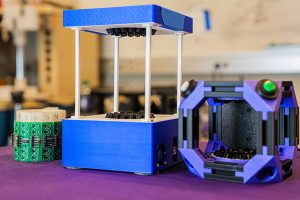
Three acoustic levitators created by Nakahara and Smith during Levity’s prototyping phase. From left to right, in order of development: The V1 model, built to work with robotic grippers and expand their capabilities; Levity’s demonstration system, which offers a clear view of levitated objects; Levity’s contactless acoustic levitation system, which can hold up to four liquid or solid samples while manipulating the levitated objects along their vertical axes.[/caption]
Nadya Peek, an assistant professor in the
UW Department of Human Centered Design & Engineering, has also contributed to this project. Nakahara said that he considers Peek to be a mentor as well as a collaborator. Peek, whose research focuses on harnessing machine precision to enable individual creativity, has contributed her expertise to help make acoustic levitation useful to researchers.
The acoustic levitation research program in Smith’s lab has already received some academic research funding through a grant Smith and Peek received in 2020 from the
National Science Foundation. Smith, Peek, and Nakahara also received a grant in 2022 from the
CoMotion Innovation Gap Fund, which supports innovations developed at the UW that have high commercialization potential. Now that he is a UW ECE-EFP fellow, Nakahara believes he has the resources and support needed to take Levity to the next level.
“In addition to the funding, this Program provides support, mentorship, and networking opportunities through CoMotion,” Nakahara said. “The Fellows Program also gives us access to all the connections the University itself has, so we can leverage that network. Taken together, this enables us to grow in the right way, do additional customer discovery, and validate and de-risk our ideas before the acoustic levitator goes to the marketplace.”
Nakahara is currently in the midst of building what he calls a “minimum lovable product” — a top-tier product that Levity's customer base will love so much, they won’t want to do without it. To this end, he is distributing prototype systems to labs at the UW and gathering user feedback to fine-tune the product to the user’s wants and needs. He is also planning for growth in the coming year, when he anticipates distributing acoustic levitation system prototypes to research groups at other universities as well as companies that could use these devices for bioengineering and pharmaceutical research.
Looking ahead, Nakahara said he envisions Levity’s acoustic levitation system evolving so that it could provide an even wider range of laboratory services while, at the same time, offer researchers the option to execute those functions remotely.
“The opportunity to have real-world impact that can help accelerate and maybe contribute to the next big scientific discovery is personally motivating to me, “Nakahara said. “I’m excited to see all of the awesome innovations and advances that could come downstream from providing Levity’s acoustic levitation system to talented researchers.”
Sen Zhang — MultiSensKnit
[caption id="attachment_39182" align="alignright" width="550"]
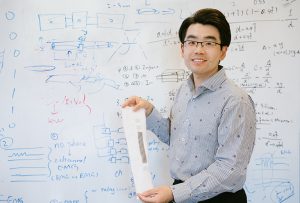
UW ECE-EFP fellow Sen Zhang holds MultiSensKnit, a smart textile for rehabilitation assessment that is wearable, comfortable, and washable. MultiSensKnit is a knitted sleeve that contains conductive yarn (the gray strip on the sleeve) and sensors that can pick up EMG and EIT signals as well as measure joint angles while worn by the user. Behind Zhang, on the whiteboard, are calculations that illustrate the working principles behind MultiSensKnit.[/caption]
Sen Zhang grew up in Anyang City in Henan Province, China. As a child, he had several creative interests, and he loved to play. He enjoyed building structures with Legos®, making small, electrical cars and toys, and sewing fabric — all activities that, looking back, served as seeds for his engineering career today.
Both of his parents were medical doctors, and they expected their son to follow in their footsteps after high school. However, Zhang heard the beat of a different drum. When it was time for him to select a university and a course of study, he decided to major in textile engineering instead of pursuing a career in medicine. Zhang attended
Jiangnan University in Jiangsu Province, China, where he studied textile production. His coursework included learning how to spin yarn from source material, such as cotton, and weave or knit that yarn into fabric. His classes also taught him how spinning, weaving, and knitting could be used as industrial-scale techniques to produce finished fabrics for the marketplace.
In 2019, Zhang received his bachelor’s degree in textile engineering from Jiangnan University. He then went on to graduate studies at North Carolina State University’s
Wilson College of Textiles. In 2020, he received his master’s degree from NC State in textile engineering. And in 2023, he also earned a master’s degree in statistics from NC State. During graduate school, Zhang studied
smart textiles — fabrics that integrate electronic components, such as sensors and actuators. He decided that he wanted to further his study in this area, so he enrolled in the College’s doctoral program, where he did research focused on textile-based, soft, wearable robotics. In 2024, he received his doctoral degree from NC State in fiber and polymer science.
“I believe we have created something in the lab that will be helpful in the clinic. And that’s why I want to push MultiSensKnit out of the lab and into the marketplace as a real-world product."
— Sen Zhang, UW ECE postdoctoral scholar and 2025–26 UW ECE-EFP fellow
That same year, Zhang joined the lab of UW ECE Assistant Professor
Yiyue Luo as a postdoctoral scholar. Luo is a leader in the development of smart textiles and wearable technologies. Her research brings together digital fabrication, human-computer/robot interaction, and applied artificial intelligence. It was a perfect fit for Zhang, and Luo’s lab provided room for him to grow in his chosen field.
“Even though the research I did in my Ph.D. program was focused on textile-based, soft, wearable robotics, I had very little experience with wearable sensors and how they could be used,” Zhang said. “Yiyue brought me into this area. She also suggested that we should explore using wearable sensors to create medical devices.”
Zhang and Luo discussed this idea with UW ECE Professor
Chet Moritz. Moritz holds joint appointments in rehabilitation medicine, physiology, and biophysics, and he is co-director of the
Center for Neurotechnology. Moritz leads the
Restorative Technologies Lab at the UW, which develops neuroprosthetic technology to treat paralysis and other movement disorders. His lab regularly brings in people who have had a spinal cord injury, stroke, or other medical conditions to test and monitor their progress using neural devices he and his research team have designed. In their conversations with Moritz, Zhang and Luo realized that his lab might provide an opportunity for them to gather valuable user feedback on wearable technology that could assess a patient’s progress with rehabilitation exercises.
In-home rehabilitation assessment using wearable technology
[caption id="attachment_39184" align="alignright" width="550"]
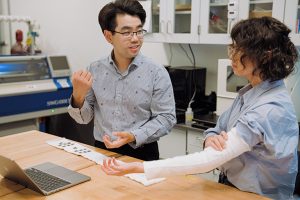
Zhang with his adviser, UW ECE Assistant Professor Yiyue Luo, who wears a MultiSensKnit prototype on her arm. Zhang developed MultiSensKnit under Luo’s guidance.[/caption]
With guidance from Luo, Zhang developed
MultiSensKnit — a smart textile for rehabilitation assessment that is wearable, comfortable, and washable. MultiSensKnit is a soft, knitted sleeve Zhang produced by knitting conductive yarn with traditional yarn on an industrial-scale knitting machine in Luo’s lab. The conductive yarn is made out of stainless-steel fibers, which are spun together to form the yarn. Although the yarn is made out of steel, it feels like traditional yarn, soft to the touch. And because stainless steel is rust, stain, and corrosion resistant, the material is washable and wearable for long periods of time.
MultiSensKnit is a multimodal sensing smart textile. This knitted sleeve is embedded with electromyography, or EMG, sensors to measure the electrical activity of muscles and nerves in the bicep, triceps, and front of the arm. The device can also measure joint angles as the arm is moved and muscles are flexed. And as if that weren’t enough, MultiSensKnit also contains electrical impedance tomography, or EIT, sensors to construct a map of tissues inside the arm.
Currently, wearable sensors for rehabilitation assessment are unwieldy, and most can only measure one type of signal or marker from the body. Today, patients are required to come into clinics to put on multiple types of bulky equipment for rehabilitation assessment. This is expensive and inconvenient, to say the least, but it also means that the patient will have to repeat their rehabilitation exercises several times wearing different types of sensors. This can be tiring for the patients and taxing on their bodies.
In contrast, MultiSensKnit allows patients to simply put on a soft, knitted sleeve and wear it, just like they would any other piece of clothing, from the comfort of their own home. Zhang, Luo, and their research team have also developed small printed circuit boards, or PCBs, each about the size of a smart phone, which patients can put in their pockets while they do their rehabilitation exercises. The PCBs pick up data from the sensors in MultiSensKnit and transmit the information wirelessly to the patient’s phone or computer, which then sends the data through the internet to the patient’s health care provider.
“With this device, your clothes function as a wearable sensor, which to me, is a very exciting idea,” Zhang said. “MultiSensKnit is washable, durable, and comfortable. You don’t need to worry about the sensor as you go about your daily life. You can just wear it like normal apparel.”
How the Fellows Program will help MultiSensKnit grow
[caption id="attachment_39185" align="alignright" width="550"]
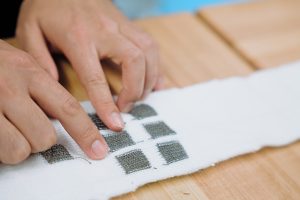
This close-up of MultiSensKnit shows gray squares of conductive yarn knit into white traditional yarn. The fabric is soft, durable, and washable. Inside the gray squares are EMG and EIT sensors that track muscle and nerve signals and can even map tissues inside the arm.[/caption]
According to the
World Health Organization, globally, an estimated 2.4 billion people are living with a health condition that could benefit from rehabilitation. And as people live longer and populations age, that number is expected to grow. This is a huge market. And because MultiSensKnit can be used to gather data from the body in several different ways, it could also be used for purposes other than rehabilitation, such as fitness tracking or helping athletes improve their performance. These areas also hold great potential for commercialization, but for now, Zhang said he is focusing their efforts primarily on providing the product to doctors and health-care clinics for rehabilitation assessment. He said he views the UW ECE-EFP as a key support mechanism for helping him to bring his research project to this marketplace.
“I really appreciate the entrepreneurship opportunities the fellowship provides. Because I’m a researcher, I spend much of my time in the lab. I did a lot of research on this smart sleeve, and I hope it can help to improve people’s lives,” Zhang said. “I didn’t know how to start a company and bring products to the market, so this Program is helping me learn how to create a startup, how to brand it, advertise, and move my product to the market, so people can buy it. It’s helping me not only to develop the technology but also to push this device out of our lab and into the real world.”
Zhang is also part of CoMotion’s Postdoctoral Entrepreneurship Program, where alongside other PEP participants, he works, studies, and learns how to commercialize a product while creating a startup. This program at CoMotion provides regular meetings and assignments for Zhang and his cohort. He will meet with an industry mentor through the PEP, which will provide further education and networking opportunities. He is also working with CoMotion to file the patent for MultiSensKnit.
In addition to filing for a patent, next steps for Zhang to commercialize MultiSensKnit include finishing the optimization of the smart sleeve according to feedback gathered from users in Moritz’ lab, setting up clinical trials for the device, and working toward acquiring Federal Drug Administration approval for the product.
When the time comes, Zhang is envisioning two stages for distributing MultiSensKnit to the public. In the first stage, he will partner with doctors, clinics, and telehealth providers. Patients will first purchase the product based on their health care provider’s recommendation. They will then work with a technician, physical therapist, or doctor, who will customize the fit of the smart sleeve to the patient’s arm and adjust electrode locations as needed. In the next stage of development, when the product is more mature, Zhang said he could imagine patients ordering MultiSensKnit directly from a major online retailer, such as Amazon. Patients could input their arm size and other parameters, then MultiSensKnit could be customized to fit that particular individual and shipped to them.
“We are using an industrial-scale, digital knitting machine, so it’s easy to customize garments for everyone. The logic is similar to a 3D printer, where you can print anything you want in any shape you desire,” Zhang said. “So, we don’t need a clothing company to cut and sew the fabric, we can produce this smart sleeve after gathering fitting information from the intended user and ship it to their home.”
Zhang has a lot to look forward to as he develops MultiSensKnit for the marketplace. And looking back, he noted where his personal motivation for this work springs from.
“Both of my parents were doctors, and I learned a lot from them and their experience in medicine. They have inspired me to make something that will help patients with the healing process,” Zhang said. “I believe we have created something in the lab that will be helpful in the clinic. And that’s why I want to push MultiSensKnit out of the lab and into the marketplace as a real-world product.”
Applications for the 2026–27 UW ECE-EFP cohort will open in the spring. More information is available on the UW ECE-EFP webpage and from UW ECE Career and Industry Programs Manager Rebecca Carlson. Both Jared Nakahara and Sen Zhang are currently open to and seeking collaborative opportunities for their research and product development. To inquire, contact Jared Nakahara at jarednak@uw.edu and Sen Zhang at szhang66@uw.edu.
[post_title] => UW ECE Entrepreneurial Fellows Program helps turn research advances into real-world products
[post_excerpt] =>
[post_status] => publish
[comment_status] => closed
[ping_status] => closed
[post_password] =>
[post_name] => uw-ece-efp-2026-26-fellows
[to_ping] =>
[pinged] =>
[post_modified] => 2025-11-12 16:44:17
[post_modified_gmt] => 2025-11-13 00:44:17
[post_content_filtered] =>
[post_parent] => 0
[guid] => https://www.ece.uw.edu/?post_type=spotlight&p=39169
[menu_order] => 4
[post_type] => spotlight
[post_mime_type] =>
[comment_count] => 0
[filter] => raw
)
[3] => WP_Post Object
(
[ID] => 39127
[post_author] => 26
[post_date] => 2025-11-06 11:29:55
[post_date_gmt] => 2025-11-06 19:29:55
[post_content] =>

Applications are now open for
two tenure-track Assistant Professor positions at UW ECE. Visit the link below to apply via Interfolio.
Deadline: December 15, 2025
https://www.ece.uw.edu/engage/job-openings/
[post_title] => UW ECE is Hiring!
[post_excerpt] =>
[post_status] => publish
[comment_status] => closed
[ping_status] => closed
[post_password] =>
[post_name] => uw-ece-is-hiring-4
[to_ping] =>
[pinged] =>
[post_modified] => 2025-11-06 11:35:38
[post_modified_gmt] => 2025-11-06 19:35:38
[post_content_filtered] =>
[post_parent] => 0
[guid] => https://www.ece.uw.edu/?post_type=spotlight&p=39127
[menu_order] => 5
[post_type] => spotlight
[post_mime_type] =>
[comment_count] => 0
[filter] => raw
)
[4] => WP_Post Object
(
[ID] => 39108
[post_author] => 27
[post_date] => 2025-11-26 17:46:46
[post_date_gmt] => 2025-11-27 01:46:46
[post_content] =>
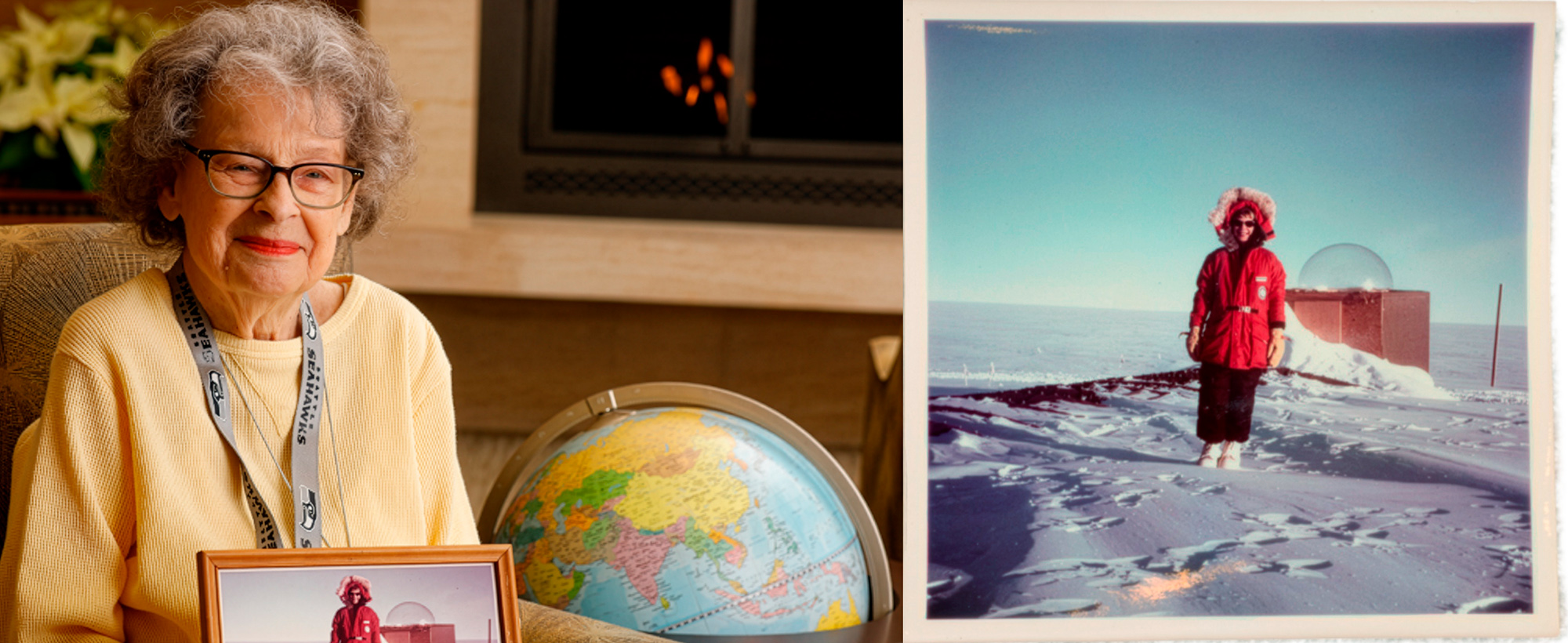 Article by Wayne Gillam
Article by Wayne Gillam /
UW ECE News
UW ECE Professor Emerita Irene Peden helped to create pathways to success for women in engineering during a time when there was no clear or easy road. An exceptional researcher and educator with confidence, grit, and a can-do attitude, Peden broke down barriers and confronted institutionalized sexism during a time when career opportunities for women were very limited. Alongside her teaching and research, she was a leader in improving engineering education, and she was a passionate advocate for women in engineering throughout her life.
Peden passed away on August 22, 2025, just a few weeks before her 100th birthday. Her accomplishments, awards, and honors are too numerous to list them all here. But illustrated below are some key milestones from her life that reflect the contributions she made as a researcher, educator, and a pioneer for women in engineering.

A life well-lived
Irene Peden was born in 1925 in Topeka, Kansas. She was the oldest of three girls, growing up during a time when an engineering career was not considered by many people to be a good fit for a woman. Her mother, who taught mathematics and music, was a strong influence. According to Peden, it was her mother who instilled in her the confidence and strength necessary to overcome challenges and obstacles that were yet to come.
“I grew up knowing that if you want to do something, no matter what kind of roadblocks they throw in your way, you just do it.”
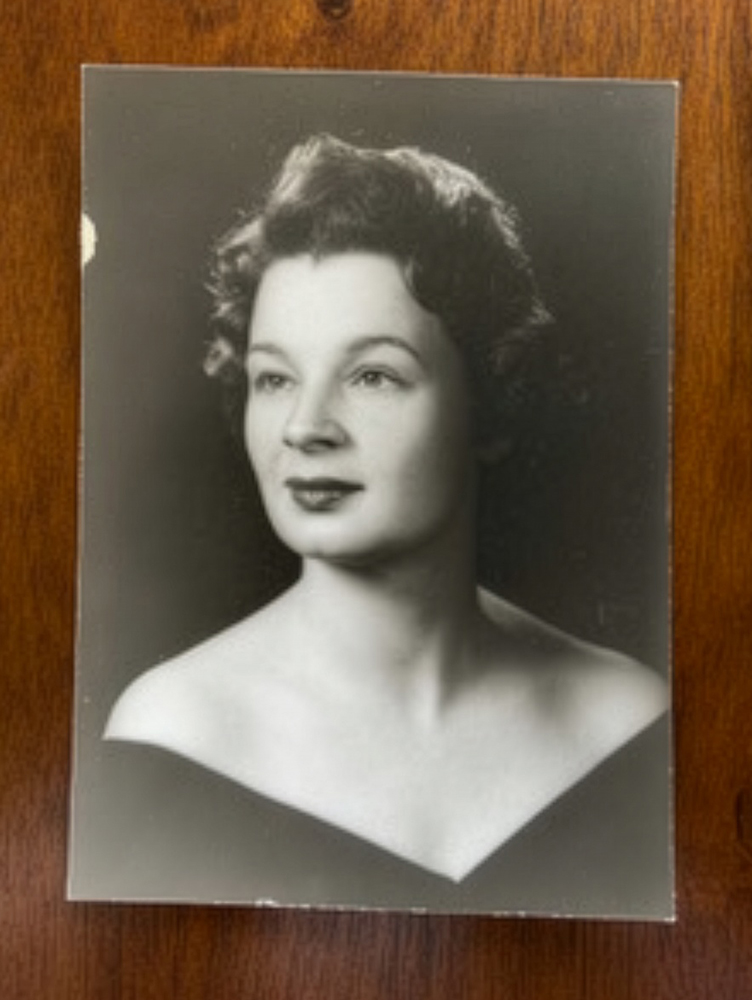 In high school, Peden discovered her love for science in a chemistry class.
In high school, Peden discovered her love for science in a chemistry class. Because she was a girl, her high school teachers and counselors discouraged her from going into science as a career, but she was undaunted. After high school, she chose to attend Kansas City Junior College, where she studied chemistry and physics. She enjoyed both subjects, especially physics, but ultimately, she decided to pursue a four-year degree in electrical engineering, thinking it would provide a more viable career path. After two years at Kansas City Junior College, she transferred to the University of Colorado, where in 1947, she graduated with her bachelor’s degree in electrical engineering.
“As an undergraduate, I remember being particularly attracted to a course in transmission lines, which was related to electromagnetic propagation — the field I ended up doing research in. My research was in a totally different context, but I loved that course. Sometimes, things tend to coalesce.”
Peden spent the first decade of her career as a professional engineer. Her first job was as an electrical engineer at the Delaware Power and Light company in Wilmington, Delaware. In 1949, Peden and her husband moved to California, so he could attend Stanford University. There, Peden got a job as a research assistant in the Aircraft Engineering and Antenna Laboratory at the Stanford Research Institute (now SRI International). It was one of the few organizations in the area that would hire a woman in engineering. She made calculations and took laboratory measurements for antenna research. The experience whetted her appetite to learn more. So, through a company program offered at SRI, she enrolled in Stanford University to pursue a master’s degree in electrical engineering. Although she had become successful in her chosen field, Peden noted the challenges women in engineering faced in those days.
“I had a difficult time getting my first job. It was the hardest thing I ever did in my life, and I’ve done some very hard things. They would simply tell me, ‘We’ve never hired a woman before, and we’re not going to talk to you,’ and shut the door. I had a lot of that to deal with.”
 Peden was the first woman to receive her doctoral degree in electrical engineering from Stanford University.
Peden was the first woman to receive her doctoral degree in electrical engineering from Stanford University. Initially starting her graduate studies part-time, she took a leave of absence in 1957 to go back to school full-time at Stanford. She later left SRI and got a job as a research assistant on campus to financially support her studies. The field had evolved by the time Peden returned to graduate school, so she had to work and study extra hours to catch up with her academic peers. Peden completed her master’s degree in 1958 and her doctoral degree in 1962. She conducted research for her doctoral dissertation in the Stanford Microwave Lab, focusing her work on measurement techniques for microwave periodic circuits.
“I have the first Ph.D. in electrical engineering that Stanford ever gave to a woman. And that was a long, lonely path. When I got my master’s degree in the electrical engineering department, there were two other women, but they didn’t go on. I was the only one who did.”
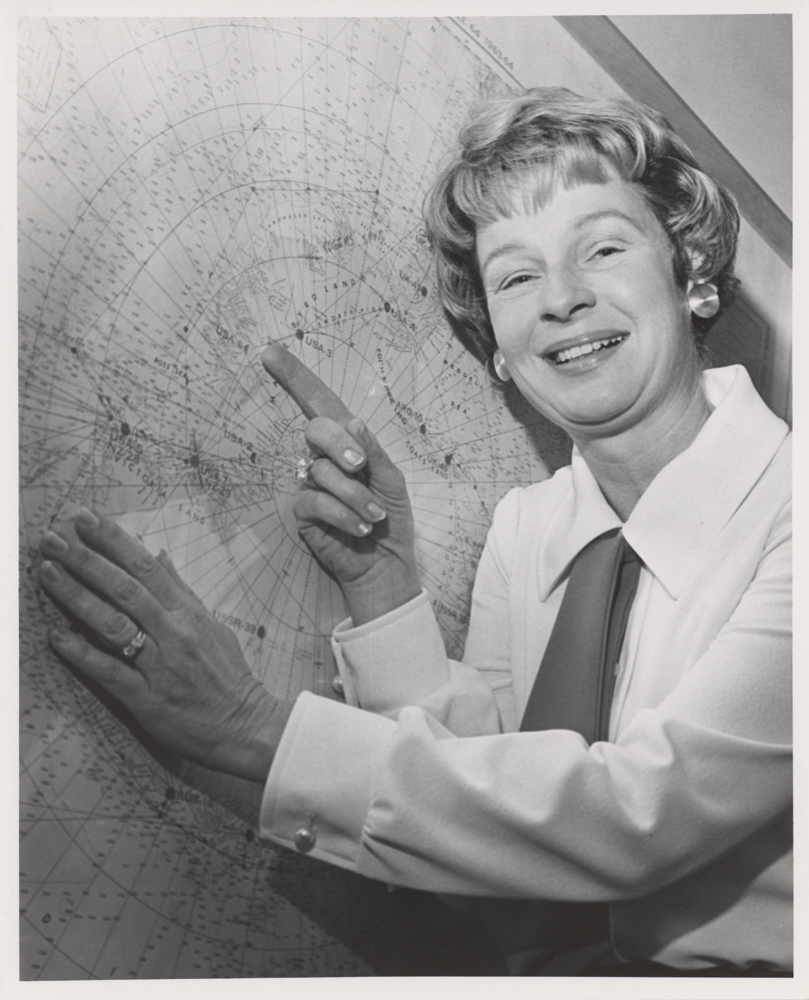 In 1962, Peden was the first female faculty member to be hired by the UW College of Engineering.
In 1962, Peden was the first female faculty member to be hired by the UW College of Engineering. After her graduate studies at Stanford, Peden accepted a position as an assistant professor at UW ECE (then UW EE). In 1971, she was promoted to full professor with tenure and remained in the Department until she retired in 1994 as a professor emerita. Her research interests covered several areas, including applied electromagnetics, radio science, antennas, and subsurface remote sensing. She spent close to 30 years at the University. Over her long career, Peden became one of the College’s most well-known and respected engineers. During her time at the UW, Peden served as associate dean in the College from 1973 to 1977 and associate chair in UW ECE from 1983 to 1986. She took a professional leave from 1991 to 1993 to serve as director of the Division of Electrical and Communications Systems at the National Science Foundation. She was known for her pioneering work and leadership in engineering education as well as her research on antennas, radio-wave propagation, and contributions to radio science in the polar regions. In 2018, she received the College’s
Diamond Award for Distinguished Service in honor of her outstanding contributions over the years to students and the field of engineering.
“When I first came to Seattle, it was April. I got off the plane, and it was a perfect Seattle day. The sky was blue, there were puffy clouds, there was salt water, there was fresh water, there were mountains. It was so beautiful, it blew my mind. I spent the day with the Department, and I met many people who I really liked and were very welcoming. I ended up deciding that I wanted to come to Seattle and be at the University of Washington.”
The Professor Irene C. Peden Electrical Engineering Fellowship supports graduate students pursuing a degree in electrical engineering with a preference given to those students who demonstrate an interest and/or active role in advancing the research and career interests of women in electrical engineering.
“Knowing that I was the recipient of the Peden Fellowship motivated me to do better, work harder, and push my thinking a bit further every step of the way.” — UW ECE alumna Tamara Bonaci (Ph.D. ‘15)
Click here to make a donation.
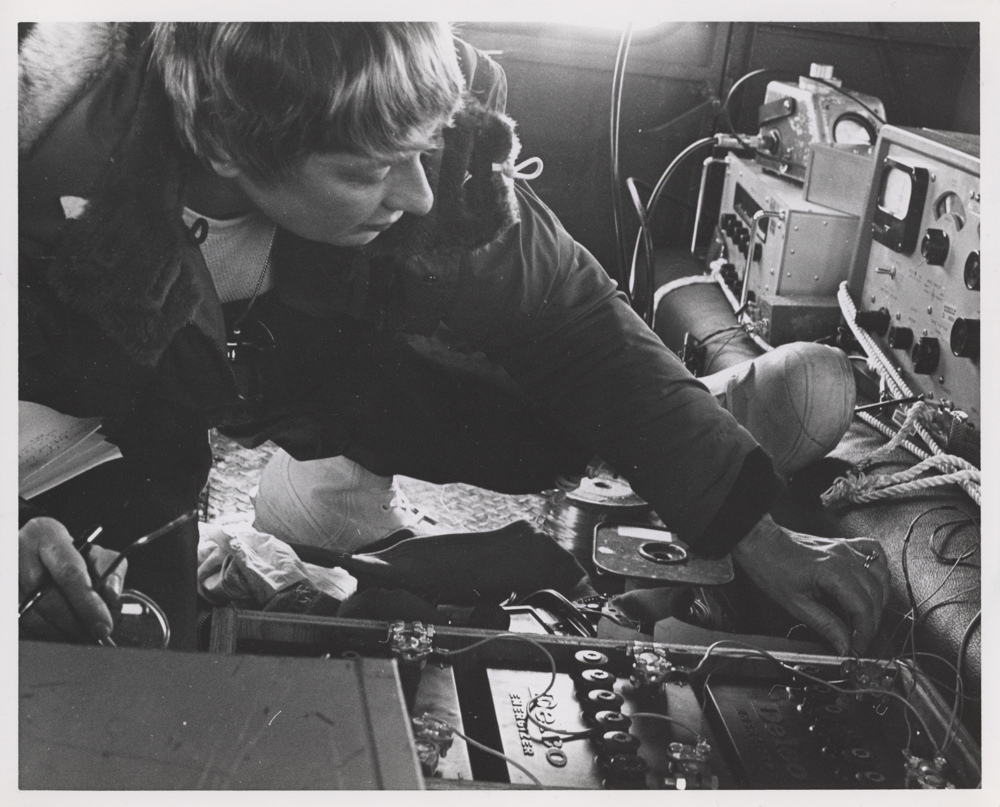 In 1970, Peden became the first American female engineer or scientist to conduct field research as a principal investigator in the interior of the Antarctic continent.
In 1970, Peden became the first American female engineer or scientist to conduct field research as a principal investigator in the interior of the Antarctic continent. She was told by officers in the U.S. Navy, who oversaw Antarctic research logistics at the time, that she could not go to Antarctica without another woman to accompany her. She was also unofficially told before she departed that if she did not complete her experiment and publish the results, another woman wouldn’t be allowed to follow in her footsteps for at least a generation. Peden’s research involved deploying a probe deep into an Antarctic ice sheet to study how very low frequency radio waves traveled through the ice and stone deep below the surface as well as how these waves bounced off the ionosphere, a layer of the earth’s atmosphere, high above. She and her students provided significant information about radio propagation and the polar ionosphere, buried antennas, electromagnetic properties of the ice sheet, and radio propagation over long paths in the polar regions. Her work was later expanded to measure the thickness of the ice sheets and search for structures underneath the surface using a variety of radio wave frequencies. In 1987, she received the U.S. Army’s Outstanding Civilian Service Medal for her research in the Antarctic. The Peden Cliffs in the Antarctic interior were also named in her honor.
“Antarctica is an exceedingly cold desert. It’s very, very dry, with low humidity. The first thing that happened to me was all my nails broke off. They did not regrow until I left. My glasses snapped in half. A technician used epoxy to put them together. I ended up with a big ball of epoxy right over the bridge of my nose, but it held the glasses together. That’s how I saw what I had to do down there.”
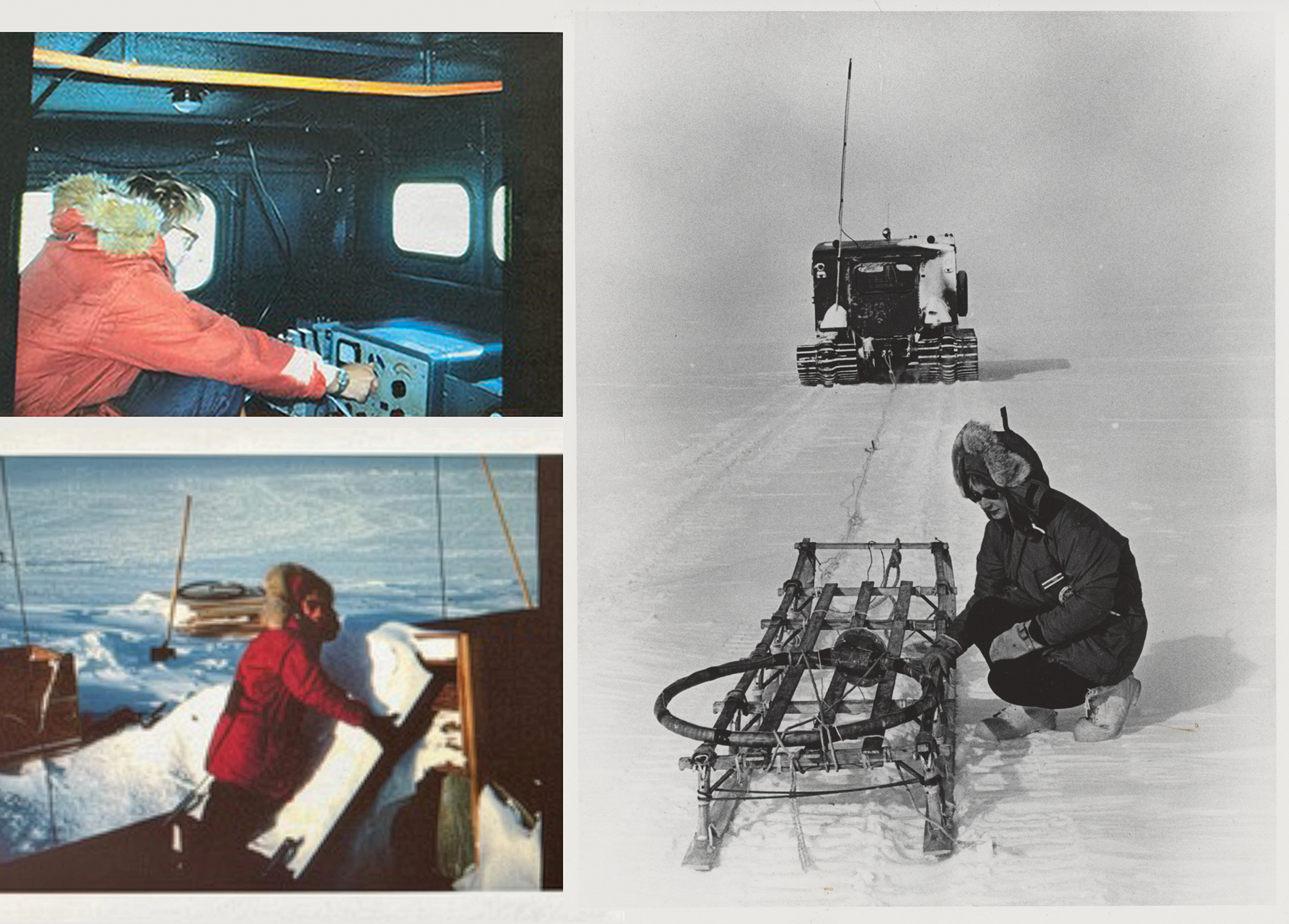 In 1989, Peden became the first female president of the Institute of Electrical and Electronics Engineers, or IEEE, Antennas and Propagation Society.
In 1989, Peden became the first female president of the Institute of Electrical and Electronics Engineers, or IEEE, Antennas and Propagation Society. She was an IEEE Fellow and was the first woman to serve on the IEEE board of directors. Over the years, she held a number of positions in the IEEE, including Vice President of Educational Activities. Peden was quite active in other professional organizations as well. She was a member of the Society of Women Engineers, helped to form the collegiate section of the SWE at the UW, and served as its faculty adviser. She also participated in and was president of the Pacific Northwest Section of the SWE. She served on several national advisory committees, including the advisory committee to the Stanford University School of Engineering. She also served as board member and chair of several science and engineering associations, including the American Association for the Advancement of Science. She was active in ABET, chaired the organization’s Engineering Accreditation Commission and served on the ABET board of directors.
“I think working with your professional society is a good way to get known — going to meetings and giving papers and circulating and talking with people, so they know who you are, where you’re from, and what kind of work you’re doing.”
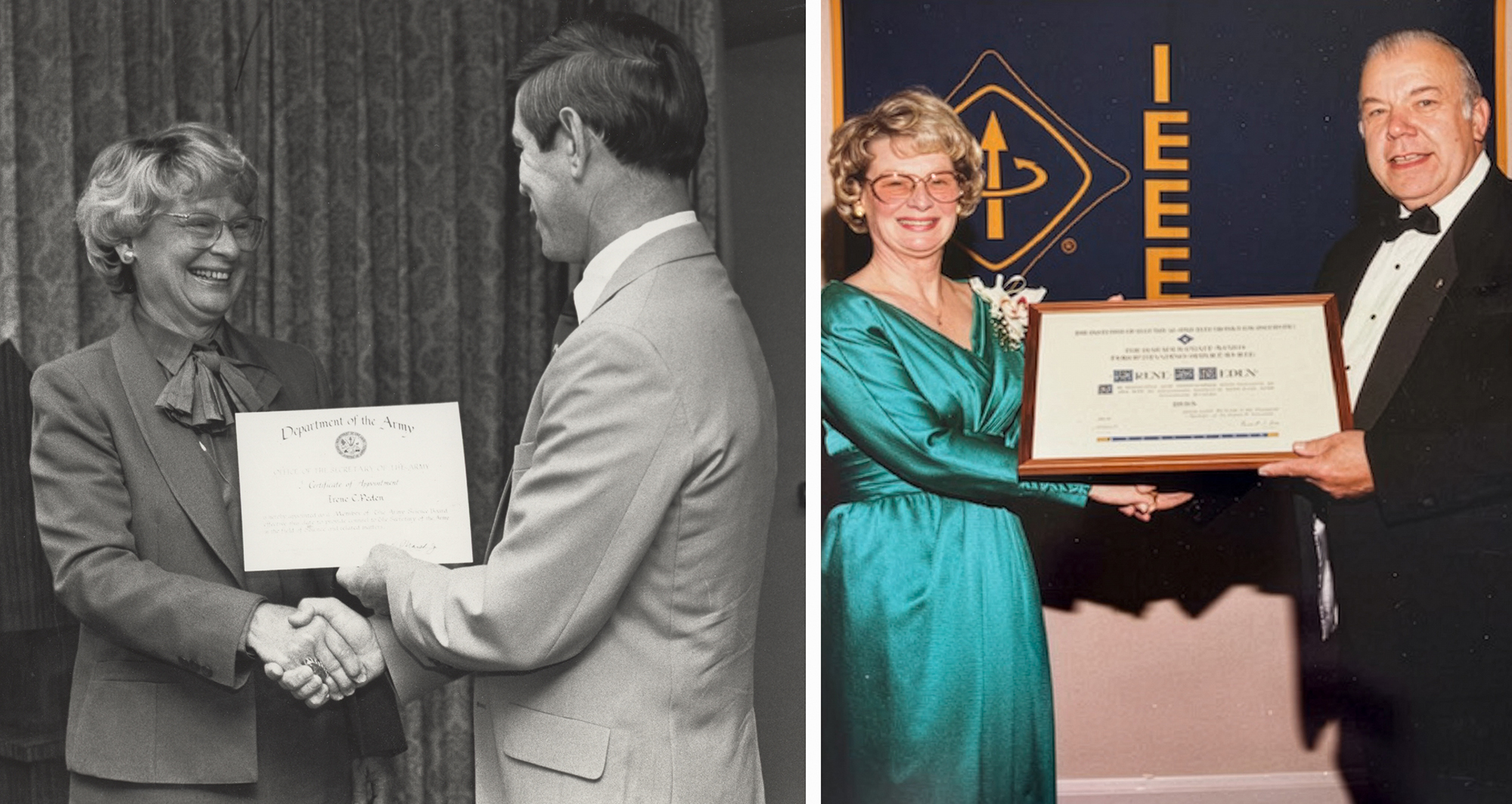 Peden received many prestigious awards and honors throughout her career
Peden received many prestigious awards and honors throughout her career, including in 1993, when she became the first of only five UW ECE faculty ever admitted into the National Academy of Engineering. That same year, she was named the National Science Foundation’s Federal Engineer of the Year and she was inducted into the American Society for Engineering Education’s Engineering Educators Hall of Fame. She was a Fellow of the AAAS, ASEE, ABET, and the SWE. She received the SWE Achievement Award in 1973. IEEE honored her with their Distinguished Achievement Award, the Centennial Medal, in 1984; the Haraden Pratt Award in 1988; and the Third Millennium Medal in 2000. She also received the Society’s “Man of the Year” award, which through its name alone, illustrated the sorts of obstacles she faced in her career.
“When I was admitted into the National Academy of Engineering, I was pretty elated. That’s one of the highest honors you can get in the field. My first thought was, ‘Gee, how did this even happen?’ I had a similar feeling the first night I spent in my little bunk twenty-five feet under the ice, 10,000 miles from home. ‘How did I get here?’ I felt very, very honored.”
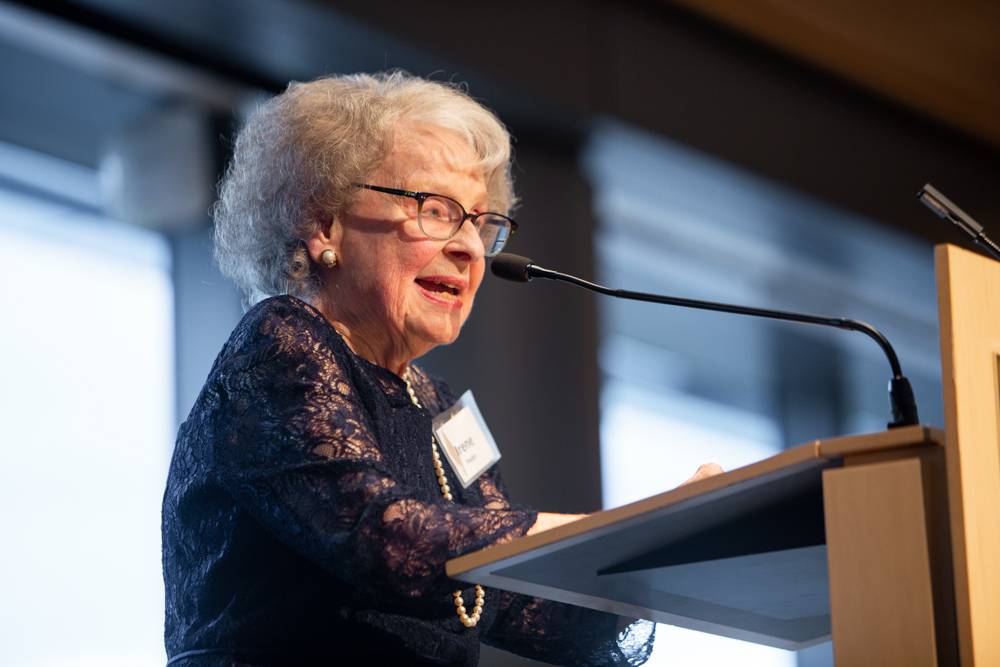 In addition to her teaching and research, Peden was an outspoken advocate for women in science, technology, engineering, and mathematics.
In addition to her teaching and research, Peden was an outspoken advocate for women in science, technology, engineering, and mathematics. She was known for helping others succeed by serving as a mentor and role model, and for working to expand pre-college engineering education for all. She fought for equal treatment for women, including through conducting salary surveys at the UW. Through her tireless efforts, Peden opened doors for female engineers to succeed on the UW campus. In 2006, the
Professor Irene C. Peden Electrical Engineering Fellowship was created in her name. Today, UW ECE exceeds the national average of women in the field for undergraduate and graduate degrees awarded and the number of women in tenured and tenure-track faculty positions. This accomplishment is thanks in large part to Peden’s pioneering career and her work in education.
“My experience was that I wasn’t very discriminated against [in the UW College of Engineering] because I was the only one. You’re just a curiosity, a singularity in the field. However, when it becomes a small group, people get nervous. And then I think that’s where discrimination comes in. If you’re a member of a small group, you’re now a minority group, and there’s something about that. But after a certain point, if there are enough of you and if you also are good at what you do, then I think you can make a change. It takes some sacrifice, and you have to choose your priorities carefully, but it’s also very rewarding.”
Lead photo (upper left, top of page) by Brian DalBalcon, University of Colorado Boulder. All other photos were provided by UW Advancement and Jefri Donovan, Peden's stepdaughter. Quotes above were lightly edited and sourced from:
[post_title] => Irene Peden — A pioneer for women in engineering
[post_excerpt] =>
[post_status] => publish
[comment_status] => closed
[ping_status] => closed
[post_password] =>
[post_name] => irene-peden-in-memoriam
[to_ping] =>
[pinged] =>
[post_modified] => 2025-12-02 15:19:53
[post_modified_gmt] => 2025-12-02 23:19:53
[post_content_filtered] =>
[post_parent] => 0
[guid] => https://www.ece.uw.edu/?post_type=spotlight&p=39108
[menu_order] => 6
[post_type] => spotlight
[post_mime_type] =>
[comment_count] => 0
[filter] => raw
)
[5] => WP_Post Object
(
[ID] => 39016
[post_author] => 27
[post_date] => 2025-10-23 10:50:29
[post_date_gmt] => 2025-10-23 17:50:29
[post_content] =>
By Wayne Gillam /
UW ECE News
[caption id="attachment_39019" align="alignright" width="600"]
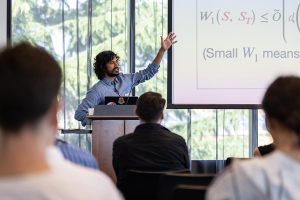
The Institute for Foundations of Data Science, led by UW ECE Professor Maryam Fazel, held the 2025 IFDS Workshop on Theoretical Foundations of Applied AI in August on the UW campus. The event brought AI and machine learning experts together from across the nation to discuss and explore the mathematical, statistical, and algorithmic underpinnings of modern AI systems — advancing theory in an effort to better understand and improve the trustworthiness, reliability, and robustness of AI technology. Shown above: Aaditya Ramdas, a professor from Carnegie Mellon University, giving a talk at the workshop. Photo by Ryan Hoover / UW ECE[/caption]
Artificial intelligence has quickly become an indispensable part of modern life. Today, AI systems support search engines, streaming services, social media, and various online tools and products over a wide range of devices. AI also enables behind-the-scenes automation in a vast array of fields, including security, finance, transportation, and health care. With such widespread use taking place, it’s fair to say that the world is now in the early stages of running on and reaping the benefits of AI and related technologies.
But alongside these benefits, people are beginning to deal with serious problems and challenges that come with this powerful technology. For example, online misinformation and disinformation has long been a problem for societies around the world, and AI is turning up the volume on these issues by making it easy to produce
fake information, images, and videos. It’s also been well-documented that algorithms underpinning AI can be biased in a multitude of different ways, skewing toward unfavorable or
damaging outcomes. In addition, wide use of AI is raising new cybersecurity vulnerabilities and opportunities for
hackers to up their game.
With all of the above in mind, the
Institute for Foundations of Data Science brought AI and machine learning experts from across the nation to the UW to discuss and explore the mathematical, statistical, and algorithmic underpinnings of modern AI systems. The
IFDS Workshop on Theoretical Foundations of Applied AI was held in August 2025 at the Bill & Melinda Gates Center for Computer Science & Engineering on the UW campus. This gathering of experts focused on discussing, exploring, and advancing theoretical understanding in an effort to improve the trustworthiness, reliability, and robustness of AI technology.
[caption id="attachment_39022" align="alignleft" width="425"]
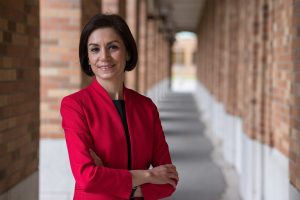
UW ECE Professor Maryam Fazel is an international leader in the study of artificial intelligence and machine learning. In addition to directing the Institute for Foundations of Data Science and co-organizing the IFDS workshop described in this article, Fazel organizes and speaks at other notable conferences, workshops, and events that bring researchers together worldwide, such as the 2025 International Conference on Machine Learning (see the ICML description and link below). Photo by Ryan Hoover / UW ECE[/caption]
“The IFDS supports cross-collaborations between faculty and student researchers from many different departments at several universities. We have collaborative projects in progress as well as published papers and talks that tackle the challenges of modern AI,” said
UW ECE Moorthy Family Professor Maryam Fazel, who is the director of the IFDS and was a co-organizer of the event. “This workshop provided another step in that direction. It brought people from different perspectives together and led to even more collaboration opportunities.”
Funded by the National Science Foundation, the IFDS is a partnership between the UW and the University of Wisconsin-Madison, the University of California Santa Cruz, and the University of Chicago. The mission of the Institute is to develop a principled approach to the analysis of complex, automated, decision-making algorithms and ever larger and potentially biased data sets that play an increasingly important role in industry, government, and academia.
“I’d like everyone to appreciate that this workshop was more than a series of lectures — it was a gathering of minds focused on making AI more principled, reliable, and understood,” said
Kevin Jamieson, an associate professor in the
Paul G. Allen School of Computer Science & Engineering, member of the IFDS leadership team, and co-organizer of the event. “This workshop reflects the IFDS’ deep commitment to pushing the boundaries of both foundational theory and real-world impact.”
Advancing theoretical understanding to improve AI systems
[caption id="attachment_39026" align="alignright" width="525"]
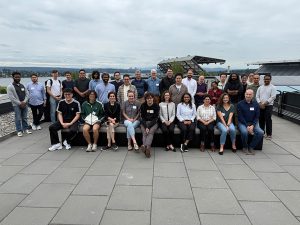
Participants in the 2025 IFDS Workshop on Theoretical Foundations of Applied AI at the Bill & Melinda Gates Center for Computer Science & Engineering on the UW campus. Photo provided by Professor Maryam Fazel.[/caption]
The IFDS workshop brought together mathematicians, statisticians, computer scientists, and other AI and machine learning experts from across the country. One of the main topics speakers and attendees discussed was how algorithms that underpin AI learn from data and how that learning process could be better understood and improved. AI models used for a variety of applications, including large language models, such as
ChatGPT, learn from data in multiple ways that are still not well understood by researchers.
For example, in addition to being trained on massive volumes of data acquired from the internet, large language models can also apply multi-step reasoning and in-context learning techniques to answer information requests and solve problems. These generative AI systems can be of great service to users when they work as intended. However, large language models sometimes generate false, misleading, or nonsensical information — occurrences that are called “
machine hallucinations.” Why these hallucinations happen is too often a mystery to those who produce large language models as well as to data science experts.
“This workshop showcased how modern mathematical theory is evolving to explain and advance state-of-the-art AI methodologies, including large language models,” said
Robert Nowak, a professor in the University of Wisconsin-Madison electrical and computer engineering department. “Advancing the mathematical foundations of AI is essential to eventually designing systems that are as trustworthy and robust as other complex engineered technologies, such as wireless networks and the internet.”
Other workshop topics included the role
artificial neural networks play in AI systems, over-parameterization (where AI models have far more learning parameters than training data), how to make AI systems more robust to cyber-attacks and hacking, and reinforcement learning, especially as applied to robotics. Throughout the workshop, special attention was paid to highlighting connections between theory and practice.
UW ECE Professor Maryam Fazel was also a program co-chair for the 2025 International Conference on Machine Learning, which was held from July 13 to 19 in Vancouver, Canada. The ICML is the oldest, second-largest, and among the fastest-growing conferences of its kind in the world. Conference attendees examined and discussed topics such as privacy, safety, algorithmic biases, and intellectual property concerns. Much like the IFDS workshop described in this article, the ICML facilitated a process that built groundwork for solutions to some of the most urgent and complex problems in AI and machine learning today. Learn more.
Organizers of the event noted that this workshop provided a venue for researchers from different fields to discuss common issues with AI technologies and work on solutions together.
“The variety of perspectives on AI foundation models was very exciting to see,” said
Zaid Harchaoui, a professor in the
UW Department of Statistics, member of the IFDS leadership team, and co-organizer of the workshop. “The understanding of these models requires concepts and tools from mathematics, statistics, computer science, and information theory.”
Next steps for many of the faculty and student researchers in attendance will be to move the fresh knowledge, insights, and collaboration opportunities they gained through this event into their daily work. Fazel said that she will be applying several things she learned at the workshop in her own research. She also underscored the value a strong theoretical understanding can bring to improving AI performance.
“AI is developing rapidly. I think the pace is faster than any other technological development in the past. And, unfortunately, theory and understanding have fallen behind while the technology has continued to move forward,” Fazel said. “Addressing challenges and making improvements to AI models and methods requires us to gain a better and deeper understanding of how AI systems work. This understanding can then help us to solve the challenges and make AI technology more reliable, robust, and trustworthy.”
Abstracts and full videos of all talks from this workshop can be found on the event website. Information about related events and activities is available on the IFDS website. More information about UW ECE Professor Maryam Fazel is available on her bio page.
[post_title] => IFDS workshop brings together experts to help make AI more reliable, robust, and trustworthy
[post_excerpt] =>
[post_status] => publish
[comment_status] => closed
[ping_status] => closed
[post_password] =>
[post_name] => ifds-workshop-brings-together-experts-to-help-make-ai-more-reliable-robust-and-trustworthy
[to_ping] =>
[pinged] =>
[post_modified] => 2025-10-23 10:58:39
[post_modified_gmt] => 2025-10-23 17:58:39
[post_content_filtered] =>
[post_parent] => 0
[guid] => https://www.ece.uw.edu/?post_type=spotlight&p=39016
[menu_order] => 7
[post_type] => spotlight
[post_mime_type] =>
[comment_count] => 0
[filter] => raw
)
)
[post_count] => 6
[current_post] => -1
[before_loop] => 1
[in_the_loop] =>
[post] => WP_Post Object
(
[ID] => 39425
[post_author] => 27
[post_date] => 2025-12-09 13:02:40
[post_date_gmt] => 2025-12-09 21:02:40
[post_content] =>
By Wayne Gillam /
UW ECE News
[caption id="attachment_39433" align="alignright" width="600"]

UW ECE doctoral student Mingfei Chen has received a 2025 Google PhD Fellowship in Machine Perception. This award supports Chen’s pioneering work developing AI systems capable of perceiving and understanding three-dimensional spaces — a capability that could transform robotics, augmented reality, and assistive technologies. Photo by Ryan Hoover / UW ECE[/caption]
UW ECE doctoral student
Mingfei Chen was recently awarded a
2025 Google PhD Fellowship in Machine Perception. This award is one of the most competitive honors for doctoral students in artificial intelligence research today.
Google.or
g awarded this fellowship to Chen to support her work developing AI systems that can sense and comprehend three-dimensional spaces. In late October, Google announced the fellowship recipients in its official blog,
The Keyword.
The
Google PhD Fellowship Program, now in its 16th year, supports outstanding graduate students who are conducting exceptional and innovative research in computer science and related fields, specifically focusing on candidates who seek to influence the future of technology. The Program provides vital direct financial support for its recipients’ doctoral degree pursuits and connects each Fellow with a dedicated Google Research Mentor, reinforcing the company’s commitment to nurturing the academic community.
Chen’s research: Spatially aware AI
Chen, a third-year doctoral student in the
UW NeuroAI Lab, which is directed by her adviser, UW ECE Associate Professor
Eli Shlizerman, is developing spatially aware multimodal AI systems that are trustworthy, safe, and human-centered. Her research focuses on enabling AI to perceive and understand three-dimensional spaces — a capability that could transform robotics,
augmented reality, and assistive technologies.
"I am very excited about building AI systems that can truly perceive the world — not just through vision and language, but through spatial awareness and more modalities." — UW ECE doctoral student Mingfei Chen
“Barely a few years into her doctoral research, Mingfei has already built cutting-edge deep learning models that combine sound and vision to create detailed representations of 3D scenes — both real and virtual,” Shlizerman said. “Now, Mingfei is daring to take this even further. She is exploring how machines equipped with deep learning can understand the scenes they perceive. It’s an exciting and bold direction, and the Google PhD Fellowship will empower Mingfei to make it a reality.”
Real-world applications
[caption id="attachment_39441" align="alignright" width="450"]

Google.org is providing over $10 million to support 255 doctoral students like Chen across 35 countries and 12 research domains, committing to a new generation of researchers who understand that accelerating scientific discovery is vital to solving the world’s toughest challenges.[/caption]
Like humans, spatially aware multimodal AI systems use sensing modalities, such as vision, sound, and motion, to build contextual awareness and an understanding of a three-dimensional space. These AI systems also use other modes, such as language and geometry, to enrich their understanding. This technology could help to make the world more accessible and supportive for people, especially for those with disabilities or limited mobility. Potential applications include:
- Spatial memory assistants: AI-equipped eyeglasses could help a person remember where they placed their keys or track how a room changes over time — using vision, sound, and spatial cues to retrieve useful information from the environment.
- Safety in dynamic environments: Wearable devices could detect approaching vehicles or obstacles outside a person’s field of view and provide directional audio alerts.
- Interactive spatial guidance: AI assistants could help people navigate complex environments by aligning audio cues with visual context. For example, when an assistant says “the object on your left,” the sound could originate from the user’s left side, linking language, vision, and spatial geometry. In public spaces like museums, these assistants could fuse real-time visual recognition with spatial audio to direct visitors toward exhibits and deliver information hands-free, enabling intuitive navigation without relying solely on sight.
- Immersive virtual re-experiencing: Spatially aware multimodal AI systems could recreate real environments for virtual tourism or memory replay. Instead of viewing static images or videos, users could “re-live” dynamic scenes (for example, standing near a landmark like the Eiffel Tower) with spatial audio and 3D geometry that deliver a natural, embodied experience.
Empowering STEM education
Chen is also passionate about contributing to STEM education and entrepreneurship. For the past two years, she has served as lead teaching assistant for UW ECE’s
Engineering Innovation and Entrepreneurship (ENGINE) capstone program, mentoring over 100 students and coordinating a team of eight teaching assistants. Through ENGINE, Chen has helped foster interdisciplinary collaboration on real-world engineering projects with leading technology companies. She said she is excited to contribute to similar projects in the future through the University as well as through global collaboration opportunities, such as those the Google PhD Fellowship might provide.
Looking ahead
Chen said that this fellowship gives her freedom to pursue unconventional and challenging research directions without being constrained by short-term trends in the field. She is looking forward to collaborating with Google researchers and continuing to build AI systems that enhance productivity, autonomy, and quality of life.
“I am very excited about building AI systems that can truly perceive the world — not just through vision and language, but through spatial awareness and more modalities,” Chen said. “Humans intuitively combine sight, sound, and context to understand the three-dimensional world around us. Pursuing this direction could unlock a deeper form of perception for AI — crucial for future technologies like smart glasses, spatial assistants, and personal robots.”
For more information about Mingfei Chen and her research, visit the UW NeuroAI Lab website.
[post_title] => UW ECE graduate student Mingfei Chen receives 2025 Google PhD Fellowship for pioneering AI research
[post_excerpt] =>
[post_status] => publish
[comment_status] => closed
[ping_status] => closed
[post_password] =>
[post_name] => mingfei-chen-2025-google-phd-fellowship-2
[to_ping] =>
[pinged] =>
[post_modified] => 2025-12-09 13:02:40
[post_modified_gmt] => 2025-12-09 21:02:40
[post_content_filtered] =>
[post_parent] => 0
[guid] => https://www.ece.uw.edu/?post_type=spotlight&p=39425
[menu_order] => 1
[post_type] => spotlight
[post_mime_type] =>
[comment_count] => 0
[filter] => raw
)
[comment_count] => 0
[current_comment] => -1
[found_posts] => 933
[max_num_pages] => 156
[max_num_comment_pages] => 0
[is_single] =>
[is_preview] =>
[is_page] =>
[is_archive] => 1
[is_date] =>
[is_year] =>
[is_month] =>
[is_day] =>
[is_time] =>
[is_author] =>
[is_category] =>
[is_tag] =>
[is_tax] =>
[is_search] =>
[is_feed] =>
[is_comment_feed] =>
[is_trackback] =>
[is_home] =>
[is_privacy_policy] =>
[is_404] =>
[is_embed] =>
[is_paged] =>
[is_admin] =>
[is_attachment] =>
[is_singular] =>
[is_robots] =>
[is_favicon] =>
[is_posts_page] =>
[is_post_type_archive] => 1
[query_vars_hash:WP_Query:private] => 259bd492f9be11f3568840d89049228d
[query_vars_changed:WP_Query:private] => 1
[thumbnails_cached] =>
[allow_query_attachment_by_filename:protected] =>
[stopwords:WP_Query:private] =>
[compat_fields:WP_Query:private] => Array
(
[0] => query_vars_hash
[1] => query_vars_changed
)
[compat_methods:WP_Query:private] => Array
(
[0] => init_query_flags
[1] => parse_tax_query
)
[query_cache_key:WP_Query:private] => wp_query:546a52e07fdc8d0bd83964a91abfb019
)
[_type:protected] => spotlight
[_from:protected] => newsawards_landing
[_args:protected] => Array
(
[post_type] => spotlight
[meta_query] => Array
(
[0] => Array
(
[key] => type
[value] => news
[compare] => LIKE
)
)
[posts_per_page] => 6
[post_status] => publish
)
[_jids:protected] =>
[_taxa:protected] => Array
(
)
[_meta:protected] => Array
(
[0] => Array
(
[key] => type
[value] => news
[compare] => LIKE
)
)
[_metarelation:protected] => AND
[_results:protected] => Array
(
[0] => WP_Post Object
(
[ID] => 39425
[post_author] => 27
[post_date] => 2025-12-09 13:02:40
[post_date_gmt] => 2025-12-09 21:02:40
[post_content] =>
By Wayne Gillam /
UW ECE News
[caption id="attachment_39433" align="alignright" width="600"]

UW ECE doctoral student Mingfei Chen has received a 2025 Google PhD Fellowship in Machine Perception. This award supports Chen’s pioneering work developing AI systems capable of perceiving and understanding three-dimensional spaces — a capability that could transform robotics, augmented reality, and assistive technologies. Photo by Ryan Hoover / UW ECE[/caption]
UW ECE doctoral student
Mingfei Chen was recently awarded a
2025 Google PhD Fellowship in Machine Perception. This award is one of the most competitive honors for doctoral students in artificial intelligence research today.
Google.or
g awarded this fellowship to Chen to support her work developing AI systems that can sense and comprehend three-dimensional spaces. In late October, Google announced the fellowship recipients in its official blog,
The Keyword.
The
Google PhD Fellowship Program, now in its 16th year, supports outstanding graduate students who are conducting exceptional and innovative research in computer science and related fields, specifically focusing on candidates who seek to influence the future of technology. The Program provides vital direct financial support for its recipients’ doctoral degree pursuits and connects each Fellow with a dedicated Google Research Mentor, reinforcing the company’s commitment to nurturing the academic community.
Chen’s research: Spatially aware AI
Chen, a third-year doctoral student in the
UW NeuroAI Lab, which is directed by her adviser, UW ECE Associate Professor
Eli Shlizerman, is developing spatially aware multimodal AI systems that are trustworthy, safe, and human-centered. Her research focuses on enabling AI to perceive and understand three-dimensional spaces — a capability that could transform robotics,
augmented reality, and assistive technologies.
"I am very excited about building AI systems that can truly perceive the world — not just through vision and language, but through spatial awareness and more modalities." — UW ECE doctoral student Mingfei Chen
“Barely a few years into her doctoral research, Mingfei has already built cutting-edge deep learning models that combine sound and vision to create detailed representations of 3D scenes — both real and virtual,” Shlizerman said. “Now, Mingfei is daring to take this even further. She is exploring how machines equipped with deep learning can understand the scenes they perceive. It’s an exciting and bold direction, and the Google PhD Fellowship will empower Mingfei to make it a reality.”
Real-world applications
[caption id="attachment_39441" align="alignright" width="450"]

Google.org is providing over $10 million to support 255 doctoral students like Chen across 35 countries and 12 research domains, committing to a new generation of researchers who understand that accelerating scientific discovery is vital to solving the world’s toughest challenges.[/caption]
Like humans, spatially aware multimodal AI systems use sensing modalities, such as vision, sound, and motion, to build contextual awareness and an understanding of a three-dimensional space. These AI systems also use other modes, such as language and geometry, to enrich their understanding. This technology could help to make the world more accessible and supportive for people, especially for those with disabilities or limited mobility. Potential applications include:
- Spatial memory assistants: AI-equipped eyeglasses could help a person remember where they placed their keys or track how a room changes over time — using vision, sound, and spatial cues to retrieve useful information from the environment.
- Safety in dynamic environments: Wearable devices could detect approaching vehicles or obstacles outside a person’s field of view and provide directional audio alerts.
- Interactive spatial guidance: AI assistants could help people navigate complex environments by aligning audio cues with visual context. For example, when an assistant says “the object on your left,” the sound could originate from the user’s left side, linking language, vision, and spatial geometry. In public spaces like museums, these assistants could fuse real-time visual recognition with spatial audio to direct visitors toward exhibits and deliver information hands-free, enabling intuitive navigation without relying solely on sight.
- Immersive virtual re-experiencing: Spatially aware multimodal AI systems could recreate real environments for virtual tourism or memory replay. Instead of viewing static images or videos, users could “re-live” dynamic scenes (for example, standing near a landmark like the Eiffel Tower) with spatial audio and 3D geometry that deliver a natural, embodied experience.
Empowering STEM education
Chen is also passionate about contributing to STEM education and entrepreneurship. For the past two years, she has served as lead teaching assistant for UW ECE’s
Engineering Innovation and Entrepreneurship (ENGINE) capstone program, mentoring over 100 students and coordinating a team of eight teaching assistants. Through ENGINE, Chen has helped foster interdisciplinary collaboration on real-world engineering projects with leading technology companies. She said she is excited to contribute to similar projects in the future through the University as well as through global collaboration opportunities, such as those the Google PhD Fellowship might provide.
Looking ahead
Chen said that this fellowship gives her freedom to pursue unconventional and challenging research directions without being constrained by short-term trends in the field. She is looking forward to collaborating with Google researchers and continuing to build AI systems that enhance productivity, autonomy, and quality of life.
“I am very excited about building AI systems that can truly perceive the world — not just through vision and language, but through spatial awareness and more modalities,” Chen said. “Humans intuitively combine sight, sound, and context to understand the three-dimensional world around us. Pursuing this direction could unlock a deeper form of perception for AI — crucial for future technologies like smart glasses, spatial assistants, and personal robots.”
For more information about Mingfei Chen and her research, visit the UW NeuroAI Lab website.
[post_title] => UW ECE graduate student Mingfei Chen receives 2025 Google PhD Fellowship for pioneering AI research
[post_excerpt] =>
[post_status] => publish
[comment_status] => closed
[ping_status] => closed
[post_password] =>
[post_name] => mingfei-chen-2025-google-phd-fellowship-2
[to_ping] =>
[pinged] =>
[post_modified] => 2025-12-09 13:02:40
[post_modified_gmt] => 2025-12-09 21:02:40
[post_content_filtered] =>
[post_parent] => 0
[guid] => https://www.ece.uw.edu/?post_type=spotlight&p=39425
[menu_order] => 1
[post_type] => spotlight
[post_mime_type] =>
[comment_count] => 0
[filter] => raw
)
[1] => WP_Post Object
(
[ID] => 39282
[post_author] => 27
[post_date] => 2025-12-02 10:00:03
[post_date_gmt] => 2025-12-02 18:00:03
[post_content] => [caption id="attachment_39302" align="alignright" width="475"]

UW ECE Professor Maryam Fazel receives the 2025 Farkas Prize from the INFORMS Optimization Society. The award was presented on October 26 at the INFORMS Annual Meeting in Atlanta, Georgia, by Katya Scheinberg (left), Coca-Cola Foundation Chair and Professor in the H. Milton Stewart School of Industrial and Systems Engineering at Georgia Tech, and Andrea Lodi (right), the Andrew H. and Ann R. Tisch Professor of operations research and information engineering at Cornell University.[/caption]
The University of Washington Department of Electrical & Computer Engineering congratulates Professor
Maryam Fazel, recipient of the
2025 Farkas Prize from the Institute for Operations Research and the Management Sciences, or INFORMS, Optimization Society. She accepted the award in late October during the INFORMS Annual Meeting in Atlanta, Georgia.
The Farkas Prize is an annual award honoring a mid-career researcher for outstanding, career-spanning contributions to the field of optimization — a discipline that develops mathematical models and algorithms to improve decision making, advance engineering design, and provide the computational foundation for machine learning systems.
Fazel was recognized for her foundational work in optimization and her pioneering contributions to data science and artificial intelligence. The award was presented on Sunday, October 26, at the
INFORMS Annual Meeting in Atlanta, Georgia.
“I’m deeply honored to receive the Farkas Prize. Optimization has been a central theme in my research, and it’s exciting to see its growing impact on fields like data science and artificial intelligence,” Fazel said. “This recognition reflects the incredible collaborations I’ve had with students, postdoctoral scholars, and colleagues over the years, and I look forward to continuing to explore new challenges in this area.”
Fazel holds the
Moorthy Family Inspiration Career Development Professorship and serves as director of the
Institute for Foundations of Data Science at the UW. INFORMS promotes the development and application of data optimization methods and software tools to solve complex problems in operations research and management science.
Learn more about the Farkas Prize on the INFORMS website.
[post_title] => UW ECE Professor Maryam Fazel receives 2025 Farkas Prize
[post_excerpt] =>
[post_status] => publish
[comment_status] => closed
[ping_status] => closed
[post_password] =>
[post_name] => maryam-fazel-2025-farkas-prize
[to_ping] =>
[pinged] =>
[post_modified] => 2025-12-02 10:50:53
[post_modified_gmt] => 2025-12-02 18:50:53
[post_content_filtered] =>
[post_parent] => 0
[guid] => https://www.ece.uw.edu/?post_type=spotlight&p=39282
[menu_order] => 2
[post_type] => spotlight
[post_mime_type] =>
[comment_count] => 0
[filter] => raw
)
[2] => WP_Post Object
(
[ID] => 39169
[post_author] => 27
[post_date] => 2025-11-12 09:12:55
[post_date_gmt] => 2025-11-12 17:12:55
[post_content] =>
Article by Wayne Gillam, Photos by Ryan Hoover /
UW ECE News
[caption id="attachment_39171" align="alignright" width="550"]

The new UW ECE Entrepreneurial Fellows Program, or UW ECE-EFP, helps translate research into real-world impact. On the left, UW ECE-EFP fellow Jared Nakahara adds droplets into an acoustic levitation prototype he created with his adviser, UW ECE and Allen School Professor Joshua Smith. Together, they co-founded Levity, a startup building acoustic levitators for lab automation. On the right, UW ECE-EFP fellow Sen Zhang holds MultiSensKnit, a sensor-packed knitted sleeve designed for rehabilitation assessment. Zhang created and developed MultiSensKnit with UW ECE Assistant Professor Yiyue Luo.[/caption]
According to the UW’s innovation hub,
CoMotion, UW ECE consistently ranks among the University’s leading generators of startup companies. The Department has maintained this distinction for decades, alongside its strong academic reputation and longstanding history of supporting entrepreneurship. But UW ECE isn’t resting on that legacy. In early 2025, the Department created a new program aimed at fostering and developing entrepreneurs.
The new
UW ECE Entrepreneurial Fellows Program, or UW ECE-EFP, is funded exclusively by royalties earned on UW ECE innovations. The Program is designed to support the transfer of research advances into commercialized impact through prototyping, customer discovery, and market analysis.
“This new program enables fellowship recipients to leverage the richness of the entrepreneurial spirit that’s within UW ECE, the UW College of Engineering, and the broader University,” said UW ECE Career and Industry Programs Manager
Rebecca Carlson, who facilitates the UW ECE-EFP. “There is a wide variety of instructors and professors here who have started companies, staff and Department affiliates with industry experience, and an alumni network that can help support our fellows in their entrepreneurial endeavors.”
“Innovation starts here because our Department is a place where ideas are born and developed in a serious way.”
— UW ECE Professor and Chair Eric Klavins
Fellowship recipients receive a postdoctoral scholar salary and benefits for one year, partial salary support for their faculty adviser, mentorship from the University's network of industry experts and entrepreneurs, and support for travel and expenses. UW ECE also partners with the CoMotion
Postdoctoral Entrepreneurship Program to provide fellowship recipients with access to an entrepreneurial cohort and a strong support network. This close partnership with CoMotion helps fellows move their research out of the lab and into the marketplace. Current UW ECE doctoral students and postdoctoral scholars as well as those eligible for a postdoctoral scholar position in the Department can apply to the UW ECE-EFP.
“Innovation starts here because our Department is a place where ideas are born and developed in a serious way,” said UW ECE Professor and Chair
Eric Klavins. “When we promote entrepreneurship through programs like this, it highlights one of the many ways universities benefit our greater society — serving as a supportive place where people can turn their dreams into reality.”
Read on to learn about the inaugural 2025–26 UW ECE-EFP fellows and how, with the help of this new program, they are each realizing their own vision for the future by turning their research projects into commercial ventures.
Jared Nakahara — Levity
[caption id="attachment_39175" align="alignright" width="550"]

Levity builds acoustic levitators for automated, contamination-free experiments requiring precise control. The prototype shown above, operated by Nakahara, uses ultrasonic sound waves — well above the threshold of human hearing — to suspend and manipulate droplets and small objects in midair without physical contact.[/caption]
Born and raised in the Seattle area, Jared Nakahara first became interested in engineering when he was in high school, during a summer program at the
DigiPen Institute of Technology, a video game and arts college located in Redmond, Washington. The program was provided by the
Washington Network for Innovative Careers, and it gave Nakahara his first exposure to robotics, coding, and mechatronics — technology combining mechanical engineering and electronics. Talented in sports and contemplating a career in baseball, Nakahara was inspired by the WANIC program to have a change of heart. He moved his focus from baseball to engineering. Both of Nakahara’s parents were engineers, and being familiar with the field, they encouraged this new direction for their son.
The WANIC summer program sparked what became for Nakahara a passionate interest in electrical and computer engineering. He decided to pursue engineering as a career, and he returned to DigiPen in subsequent years to teach engineering topics to pre-college students. Nakahara chose to study engineering at UW ECE, and he took his education all the way, earning his bachelor’s, master’s, and doctoral degrees in electrical engineering in 2018, 2021, and 2025, respectively.
As a UW ECE undergraduate, Nakahara was initially interested in quantum computing technologies, but after taking a course on field-programmable gate arrays, or FPGAs, taught by UW ECE and Allen School Professor
Joshua Smith, his interest shifted to neural engineering. Smith, who is a research leader in the
Center for Neurotechnology, was building implantable neural interfaces for spinal cord rehabilitation. The topic fascinated Nakahara. So much so, he joined Smith’s
Sensor Systems Laboratory, and when he started graduate school, Smith became his faculty adviser. Today, Nakahara is a postdoctoral scholar in Smith’s lab.
“I think the programmable laboratory space is interesting because we can potentially help to build life-saving pharmaceuticals, treatments for cancer, and personalized medicine as well as other new pharmaceuticals that could be coming to market.”
— Jared Nakahara, UW ECE postdoctoral scholar and 2025–26 UW ECE-EFP fellow
When Nakahara was a graduate student, he and Smith were inspired by
transcranial magnetic stimulation, a treatment used for neural disorders, such as depression. With this in mind, they began investigating ways to use
acoustic levitation technology to build a non-invasive stimulator for neurons. Acoustic levitation uses high-frequency sound waves (ultrasound) to suspend and move matter in liquids or gas, overcoming gravity. Around this same time, Nakahara developed an interest in robotic manipulation. He built and experimented with different acoustic levitation systems, aiming to develop a tool that could augment the capabilities of general-purpose robots, giving these robots improved manipulation precision and the ability to handle small or fragile objects without making physical contact.
“Bringing the acoustic levitator into the robotic sphere became a fascinating thing for me because I could do it very quickly, innovating on the controls as well as the hardware and software stack,” Nakahara said. “Once I went down that rabbit hole, it evolved into a much bigger thing when I realized our acoustic levitator could be used as a robotic manipulation platform.”
Through discussions with Smith, Nakahara realized that the acoustic levitator they were developing could be beneficial for laboratory experiments in bioengineering and materials science that needed to be automated, contamination-free, and executed with precision. With Smith’s support, Nakahara switched his research focus from neural engineering to acoustic levitation systems. Now, he and Smith are in the early stages of co-founding
Levity, a startup company dedicated to building acoustic levitators for laboratory automation.
An acoustic levitation system for next-generation laboratory automation
[caption id="attachment_39177" align="alignright" width="550"]

Levity’s tabletop acoustic levitation system is quick to set up and operate, and it can even run remotely. Nakahara demonstrates the prototype while Smith observes — showing how easy this device is to use.[/caption]
What Levity’s acoustic levitation system does could seem like science fiction. The device uses high-frequency sound, well above the threshold of human hearing, to levitate, contain, and manipulate liquids and small objects in midair — all without touching the levitated material. This levitator is a completely enclosed tabletop system that can contain filtered air or inert gases useful for laboratory experimentation, such as helium, or argon. The sound waves it generates create three-dimensional traps, pockets of sound pressure, which provide a contactless, contamination-free way of containing, manipulating, and examining liquids, solids, and living organisms. Because it uses ultrasound, the device is inaudible to humans and safe for people to use as well as for any living organism the device might contain.
“One of the nice things our acoustic levitator can do is lift, manipulate, and contain living organisms without harming them,” Nakahara said. “You can put a living ant or mosquito into this device and examine it with a camera. You can look at the entire specimen while it’s alive, do species identification, and extract much more information than you could from a more conventional platform.”
The advantages of Nakahara and Smith’s levitator as compared to other laboratory automation systems are many. Because it is a completely enclosed, contactless system, it provides an encapsulated environment for experiments. It is capable of mixing liquids and manipulating levitated objects ranging from millimeters to nanometers in diameter— all without touching or contaminating the experimental material. It also can be programmed to automate the manipulation and data collection tasks of laboratory experiments, removing typical and often costly human errors that happen when people pipette liquids and handle materials. The device enables the user to view the reaction progress of their experiment from start to finish as well as examine it in great detail with cameras, spectrometers, or other sensors. This complete encapsulation and tight integration of the experimental procedure allows researchers to gather much more reliable data than what would otherwise be possible when using multiple pieces of equipment. And as a high-precision scientific instrument, this acoustic levitation system can measure the mass of levitated matter down to a nanogram without touching it.
In addition, Levity’s acoustic levitation system is a tabletop device that is easy to set up and use, and it can be run remotely offsite. Nakahara said that accessible, remote operation could open up a world of possibilities for users. For example, the levitator could be set up in underserved or hard-to-reach areas to run fast and accurate on-site tests for diseases. Or researchers could automate and run their experiments from outside the lab, enabling them to do other things while saving time and money. Or several of these acoustic levitators working together could be set up to operate much like a computer server farm does today — providing automated laboratory services for many different users, all from one, compact location.
Levity’s acoustic levitation system could appeal to researchers working in many different types of scientific applications. But for now, Nakahara said he sees Levity’s primary market being researchers who need liquid handling systems for DNA, proteins, and microscopic materials as part of their workflow, for example, when scientists are developing pharmaceuticals or medical diagnostics.
“I think the programmable laboratory space is interesting because we can potentially help to build life-saving pharmaceuticals, treatments for cancer, and personalized medicine as well as other new pharmaceuticals that could be coming to market,” Nakahara said. “If we can help doctors as well as the health-care industry provide faster diagnoses and better treatments, then that’s something of great benefit to everybody.”
How the Fellows Program will help Levity grow
[caption id="attachment_39180" align="alignright" width="550"]

Three acoustic levitators created by Nakahara and Smith during Levity’s prototyping phase. From left to right, in order of development: The V1 model, built to work with robotic grippers and expand their capabilities; Levity’s demonstration system, which offers a clear view of levitated objects; Levity’s contactless acoustic levitation system, which can hold up to four liquid or solid samples while manipulating the levitated objects along their vertical axes.[/caption]
Nadya Peek, an assistant professor in the
UW Department of Human Centered Design & Engineering, has also contributed to this project. Nakahara said that he considers Peek to be a mentor as well as a collaborator. Peek, whose research focuses on harnessing machine precision to enable individual creativity, has contributed her expertise to help make acoustic levitation useful to researchers.
The acoustic levitation research program in Smith’s lab has already received some academic research funding through a grant Smith and Peek received in 2020 from the
National Science Foundation. Smith, Peek, and Nakahara also received a grant in 2022 from the
CoMotion Innovation Gap Fund, which supports innovations developed at the UW that have high commercialization potential. Now that he is a UW ECE-EFP fellow, Nakahara believes he has the resources and support needed to take Levity to the next level.
“In addition to the funding, this Program provides support, mentorship, and networking opportunities through CoMotion,” Nakahara said. “The Fellows Program also gives us access to all the connections the University itself has, so we can leverage that network. Taken together, this enables us to grow in the right way, do additional customer discovery, and validate and de-risk our ideas before the acoustic levitator goes to the marketplace.”
Nakahara is currently in the midst of building what he calls a “minimum lovable product” — a top-tier product that Levity's customer base will love so much, they won’t want to do without it. To this end, he is distributing prototype systems to labs at the UW and gathering user feedback to fine-tune the product to the user’s wants and needs. He is also planning for growth in the coming year, when he anticipates distributing acoustic levitation system prototypes to research groups at other universities as well as companies that could use these devices for bioengineering and pharmaceutical research.
Looking ahead, Nakahara said he envisions Levity’s acoustic levitation system evolving so that it could provide an even wider range of laboratory services while, at the same time, offer researchers the option to execute those functions remotely.
“The opportunity to have real-world impact that can help accelerate and maybe contribute to the next big scientific discovery is personally motivating to me, “Nakahara said. “I’m excited to see all of the awesome innovations and advances that could come downstream from providing Levity’s acoustic levitation system to talented researchers.”
Sen Zhang — MultiSensKnit
[caption id="attachment_39182" align="alignright" width="550"]

UW ECE-EFP fellow Sen Zhang holds MultiSensKnit, a smart textile for rehabilitation assessment that is wearable, comfortable, and washable. MultiSensKnit is a knitted sleeve that contains conductive yarn (the gray strip on the sleeve) and sensors that can pick up EMG and EIT signals as well as measure joint angles while worn by the user. Behind Zhang, on the whiteboard, are calculations that illustrate the working principles behind MultiSensKnit.[/caption]
Sen Zhang grew up in Anyang City in Henan Province, China. As a child, he had several creative interests, and he loved to play. He enjoyed building structures with Legos®, making small, electrical cars and toys, and sewing fabric — all activities that, looking back, served as seeds for his engineering career today.
Both of his parents were medical doctors, and they expected their son to follow in their footsteps after high school. However, Zhang heard the beat of a different drum. When it was time for him to select a university and a course of study, he decided to major in textile engineering instead of pursuing a career in medicine. Zhang attended
Jiangnan University in Jiangsu Province, China, where he studied textile production. His coursework included learning how to spin yarn from source material, such as cotton, and weave or knit that yarn into fabric. His classes also taught him how spinning, weaving, and knitting could be used as industrial-scale techniques to produce finished fabrics for the marketplace.
In 2019, Zhang received his bachelor’s degree in textile engineering from Jiangnan University. He then went on to graduate studies at North Carolina State University’s
Wilson College of Textiles. In 2020, he received his master’s degree from NC State in textile engineering. And in 2023, he also earned a master’s degree in statistics from NC State. During graduate school, Zhang studied
smart textiles — fabrics that integrate electronic components, such as sensors and actuators. He decided that he wanted to further his study in this area, so he enrolled in the College’s doctoral program, where he did research focused on textile-based, soft, wearable robotics. In 2024, he received his doctoral degree from NC State in fiber and polymer science.
“I believe we have created something in the lab that will be helpful in the clinic. And that’s why I want to push MultiSensKnit out of the lab and into the marketplace as a real-world product."
— Sen Zhang, UW ECE postdoctoral scholar and 2025–26 UW ECE-EFP fellow
That same year, Zhang joined the lab of UW ECE Assistant Professor
Yiyue Luo as a postdoctoral scholar. Luo is a leader in the development of smart textiles and wearable technologies. Her research brings together digital fabrication, human-computer/robot interaction, and applied artificial intelligence. It was a perfect fit for Zhang, and Luo’s lab provided room for him to grow in his chosen field.
“Even though the research I did in my Ph.D. program was focused on textile-based, soft, wearable robotics, I had very little experience with wearable sensors and how they could be used,” Zhang said. “Yiyue brought me into this area. She also suggested that we should explore using wearable sensors to create medical devices.”
Zhang and Luo discussed this idea with UW ECE Professor
Chet Moritz. Moritz holds joint appointments in rehabilitation medicine, physiology, and biophysics, and he is co-director of the
Center for Neurotechnology. Moritz leads the
Restorative Technologies Lab at the UW, which develops neuroprosthetic technology to treat paralysis and other movement disorders. His lab regularly brings in people who have had a spinal cord injury, stroke, or other medical conditions to test and monitor their progress using neural devices he and his research team have designed. In their conversations with Moritz, Zhang and Luo realized that his lab might provide an opportunity for them to gather valuable user feedback on wearable technology that could assess a patient’s progress with rehabilitation exercises.
In-home rehabilitation assessment using wearable technology
[caption id="attachment_39184" align="alignright" width="550"]

Zhang with his adviser, UW ECE Assistant Professor Yiyue Luo, who wears a MultiSensKnit prototype on her arm. Zhang developed MultiSensKnit under Luo’s guidance.[/caption]
With guidance from Luo, Zhang developed
MultiSensKnit — a smart textile for rehabilitation assessment that is wearable, comfortable, and washable. MultiSensKnit is a soft, knitted sleeve Zhang produced by knitting conductive yarn with traditional yarn on an industrial-scale knitting machine in Luo’s lab. The conductive yarn is made out of stainless-steel fibers, which are spun together to form the yarn. Although the yarn is made out of steel, it feels like traditional yarn, soft to the touch. And because stainless steel is rust, stain, and corrosion resistant, the material is washable and wearable for long periods of time.
MultiSensKnit is a multimodal sensing smart textile. This knitted sleeve is embedded with electromyography, or EMG, sensors to measure the electrical activity of muscles and nerves in the bicep, triceps, and front of the arm. The device can also measure joint angles as the arm is moved and muscles are flexed. And as if that weren’t enough, MultiSensKnit also contains electrical impedance tomography, or EIT, sensors to construct a map of tissues inside the arm.
Currently, wearable sensors for rehabilitation assessment are unwieldy, and most can only measure one type of signal or marker from the body. Today, patients are required to come into clinics to put on multiple types of bulky equipment for rehabilitation assessment. This is expensive and inconvenient, to say the least, but it also means that the patient will have to repeat their rehabilitation exercises several times wearing different types of sensors. This can be tiring for the patients and taxing on their bodies.
In contrast, MultiSensKnit allows patients to simply put on a soft, knitted sleeve and wear it, just like they would any other piece of clothing, from the comfort of their own home. Zhang, Luo, and their research team have also developed small printed circuit boards, or PCBs, each about the size of a smart phone, which patients can put in their pockets while they do their rehabilitation exercises. The PCBs pick up data from the sensors in MultiSensKnit and transmit the information wirelessly to the patient’s phone or computer, which then sends the data through the internet to the patient’s health care provider.
“With this device, your clothes function as a wearable sensor, which to me, is a very exciting idea,” Zhang said. “MultiSensKnit is washable, durable, and comfortable. You don’t need to worry about the sensor as you go about your daily life. You can just wear it like normal apparel.”
How the Fellows Program will help MultiSensKnit grow
[caption id="attachment_39185" align="alignright" width="550"]

This close-up of MultiSensKnit shows gray squares of conductive yarn knit into white traditional yarn. The fabric is soft, durable, and washable. Inside the gray squares are EMG and EIT sensors that track muscle and nerve signals and can even map tissues inside the arm.[/caption]
According to the
World Health Organization, globally, an estimated 2.4 billion people are living with a health condition that could benefit from rehabilitation. And as people live longer and populations age, that number is expected to grow. This is a huge market. And because MultiSensKnit can be used to gather data from the body in several different ways, it could also be used for purposes other than rehabilitation, such as fitness tracking or helping athletes improve their performance. These areas also hold great potential for commercialization, but for now, Zhang said he is focusing their efforts primarily on providing the product to doctors and health-care clinics for rehabilitation assessment. He said he views the UW ECE-EFP as a key support mechanism for helping him to bring his research project to this marketplace.
“I really appreciate the entrepreneurship opportunities the fellowship provides. Because I’m a researcher, I spend much of my time in the lab. I did a lot of research on this smart sleeve, and I hope it can help to improve people’s lives,” Zhang said. “I didn’t know how to start a company and bring products to the market, so this Program is helping me learn how to create a startup, how to brand it, advertise, and move my product to the market, so people can buy it. It’s helping me not only to develop the technology but also to push this device out of our lab and into the real world.”
Zhang is also part of CoMotion’s Postdoctoral Entrepreneurship Program, where alongside other PEP participants, he works, studies, and learns how to commercialize a product while creating a startup. This program at CoMotion provides regular meetings and assignments for Zhang and his cohort. He will meet with an industry mentor through the PEP, which will provide further education and networking opportunities. He is also working with CoMotion to file the patent for MultiSensKnit.
In addition to filing for a patent, next steps for Zhang to commercialize MultiSensKnit include finishing the optimization of the smart sleeve according to feedback gathered from users in Moritz’ lab, setting up clinical trials for the device, and working toward acquiring Federal Drug Administration approval for the product.
When the time comes, Zhang is envisioning two stages for distributing MultiSensKnit to the public. In the first stage, he will partner with doctors, clinics, and telehealth providers. Patients will first purchase the product based on their health care provider’s recommendation. They will then work with a technician, physical therapist, or doctor, who will customize the fit of the smart sleeve to the patient’s arm and adjust electrode locations as needed. In the next stage of development, when the product is more mature, Zhang said he could imagine patients ordering MultiSensKnit directly from a major online retailer, such as Amazon. Patients could input their arm size and other parameters, then MultiSensKnit could be customized to fit that particular individual and shipped to them.
“We are using an industrial-scale, digital knitting machine, so it’s easy to customize garments for everyone. The logic is similar to a 3D printer, where you can print anything you want in any shape you desire,” Zhang said. “So, we don’t need a clothing company to cut and sew the fabric, we can produce this smart sleeve after gathering fitting information from the intended user and ship it to their home.”
Zhang has a lot to look forward to as he develops MultiSensKnit for the marketplace. And looking back, he noted where his personal motivation for this work springs from.
“Both of my parents were doctors, and I learned a lot from them and their experience in medicine. They have inspired me to make something that will help patients with the healing process,” Zhang said. “I believe we have created something in the lab that will be helpful in the clinic. And that’s why I want to push MultiSensKnit out of the lab and into the marketplace as a real-world product.”
Applications for the 2026–27 UW ECE-EFP cohort will open in the spring. More information is available on the UW ECE-EFP webpage and from UW ECE Career and Industry Programs Manager Rebecca Carlson. Both Jared Nakahara and Sen Zhang are currently open to and seeking collaborative opportunities for their research and product development. To inquire, contact Jared Nakahara at jarednak@uw.edu and Sen Zhang at szhang66@uw.edu.
[post_title] => UW ECE Entrepreneurial Fellows Program helps turn research advances into real-world products
[post_excerpt] =>
[post_status] => publish
[comment_status] => closed
[ping_status] => closed
[post_password] =>
[post_name] => uw-ece-efp-2026-26-fellows
[to_ping] =>
[pinged] =>
[post_modified] => 2025-11-12 16:44:17
[post_modified_gmt] => 2025-11-13 00:44:17
[post_content_filtered] =>
[post_parent] => 0
[guid] => https://www.ece.uw.edu/?post_type=spotlight&p=39169
[menu_order] => 4
[post_type] => spotlight
[post_mime_type] =>
[comment_count] => 0
[filter] => raw
)
[3] => WP_Post Object
(
[ID] => 39127
[post_author] => 26
[post_date] => 2025-11-06 11:29:55
[post_date_gmt] => 2025-11-06 19:29:55
[post_content] =>

Applications are now open for
two tenure-track Assistant Professor positions at UW ECE. Visit the link below to apply via Interfolio.
Deadline: December 15, 2025
https://www.ece.uw.edu/engage/job-openings/
[post_title] => UW ECE is Hiring!
[post_excerpt] =>
[post_status] => publish
[comment_status] => closed
[ping_status] => closed
[post_password] =>
[post_name] => uw-ece-is-hiring-4
[to_ping] =>
[pinged] =>
[post_modified] => 2025-11-06 11:35:38
[post_modified_gmt] => 2025-11-06 19:35:38
[post_content_filtered] =>
[post_parent] => 0
[guid] => https://www.ece.uw.edu/?post_type=spotlight&p=39127
[menu_order] => 5
[post_type] => spotlight
[post_mime_type] =>
[comment_count] => 0
[filter] => raw
)
[4] => WP_Post Object
(
[ID] => 39108
[post_author] => 27
[post_date] => 2025-11-26 17:46:46
[post_date_gmt] => 2025-11-27 01:46:46
[post_content] =>
 Article by Wayne Gillam
Article by Wayne Gillam /
UW ECE News
UW ECE Professor Emerita Irene Peden helped to create pathways to success for women in engineering during a time when there was no clear or easy road. An exceptional researcher and educator with confidence, grit, and a can-do attitude, Peden broke down barriers and confronted institutionalized sexism during a time when career opportunities for women were very limited. Alongside her teaching and research, she was a leader in improving engineering education, and she was a passionate advocate for women in engineering throughout her life.
Peden passed away on August 22, 2025, just a few weeks before her 100th birthday. Her accomplishments, awards, and honors are too numerous to list them all here. But illustrated below are some key milestones from her life that reflect the contributions she made as a researcher, educator, and a pioneer for women in engineering.

A life well-lived
Irene Peden was born in 1925 in Topeka, Kansas. She was the oldest of three girls, growing up during a time when an engineering career was not considered by many people to be a good fit for a woman. Her mother, who taught mathematics and music, was a strong influence. According to Peden, it was her mother who instilled in her the confidence and strength necessary to overcome challenges and obstacles that were yet to come.
“I grew up knowing that if you want to do something, no matter what kind of roadblocks they throw in your way, you just do it.”
 In high school, Peden discovered her love for science in a chemistry class.
In high school, Peden discovered her love for science in a chemistry class. Because she was a girl, her high school teachers and counselors discouraged her from going into science as a career, but she was undaunted. After high school, she chose to attend Kansas City Junior College, where she studied chemistry and physics. She enjoyed both subjects, especially physics, but ultimately, she decided to pursue a four-year degree in electrical engineering, thinking it would provide a more viable career path. After two years at Kansas City Junior College, she transferred to the University of Colorado, where in 1947, she graduated with her bachelor’s degree in electrical engineering.
“As an undergraduate, I remember being particularly attracted to a course in transmission lines, which was related to electromagnetic propagation — the field I ended up doing research in. My research was in a totally different context, but I loved that course. Sometimes, things tend to coalesce.”
Peden spent the first decade of her career as a professional engineer. Her first job was as an electrical engineer at the Delaware Power and Light company in Wilmington, Delaware. In 1949, Peden and her husband moved to California, so he could attend Stanford University. There, Peden got a job as a research assistant in the Aircraft Engineering and Antenna Laboratory at the Stanford Research Institute (now SRI International). It was one of the few organizations in the area that would hire a woman in engineering. She made calculations and took laboratory measurements for antenna research. The experience whetted her appetite to learn more. So, through a company program offered at SRI, she enrolled in Stanford University to pursue a master’s degree in electrical engineering. Although she had become successful in her chosen field, Peden noted the challenges women in engineering faced in those days.
“I had a difficult time getting my first job. It was the hardest thing I ever did in my life, and I’ve done some very hard things. They would simply tell me, ‘We’ve never hired a woman before, and we’re not going to talk to you,’ and shut the door. I had a lot of that to deal with.”
 Peden was the first woman to receive her doctoral degree in electrical engineering from Stanford University.
Peden was the first woman to receive her doctoral degree in electrical engineering from Stanford University. Initially starting her graduate studies part-time, she took a leave of absence in 1957 to go back to school full-time at Stanford. She later left SRI and got a job as a research assistant on campus to financially support her studies. The field had evolved by the time Peden returned to graduate school, so she had to work and study extra hours to catch up with her academic peers. Peden completed her master’s degree in 1958 and her doctoral degree in 1962. She conducted research for her doctoral dissertation in the Stanford Microwave Lab, focusing her work on measurement techniques for microwave periodic circuits.
“I have the first Ph.D. in electrical engineering that Stanford ever gave to a woman. And that was a long, lonely path. When I got my master’s degree in the electrical engineering department, there were two other women, but they didn’t go on. I was the only one who did.”
 In 1962, Peden was the first female faculty member to be hired by the UW College of Engineering.
In 1962, Peden was the first female faculty member to be hired by the UW College of Engineering. After her graduate studies at Stanford, Peden accepted a position as an assistant professor at UW ECE (then UW EE). In 1971, she was promoted to full professor with tenure and remained in the Department until she retired in 1994 as a professor emerita. Her research interests covered several areas, including applied electromagnetics, radio science, antennas, and subsurface remote sensing. She spent close to 30 years at the University. Over her long career, Peden became one of the College’s most well-known and respected engineers. During her time at the UW, Peden served as associate dean in the College from 1973 to 1977 and associate chair in UW ECE from 1983 to 1986. She took a professional leave from 1991 to 1993 to serve as director of the Division of Electrical and Communications Systems at the National Science Foundation. She was known for her pioneering work and leadership in engineering education as well as her research on antennas, radio-wave propagation, and contributions to radio science in the polar regions. In 2018, she received the College’s
Diamond Award for Distinguished Service in honor of her outstanding contributions over the years to students and the field of engineering.
“When I first came to Seattle, it was April. I got off the plane, and it was a perfect Seattle day. The sky was blue, there were puffy clouds, there was salt water, there was fresh water, there were mountains. It was so beautiful, it blew my mind. I spent the day with the Department, and I met many people who I really liked and were very welcoming. I ended up deciding that I wanted to come to Seattle and be at the University of Washington.”
The Professor Irene C. Peden Electrical Engineering Fellowship supports graduate students pursuing a degree in electrical engineering with a preference given to those students who demonstrate an interest and/or active role in advancing the research and career interests of women in electrical engineering.
“Knowing that I was the recipient of the Peden Fellowship motivated me to do better, work harder, and push my thinking a bit further every step of the way.” — UW ECE alumna Tamara Bonaci (Ph.D. ‘15)
Click here to make a donation.
 In 1970, Peden became the first American female engineer or scientist to conduct field research as a principal investigator in the interior of the Antarctic continent.
In 1970, Peden became the first American female engineer or scientist to conduct field research as a principal investigator in the interior of the Antarctic continent. She was told by officers in the U.S. Navy, who oversaw Antarctic research logistics at the time, that she could not go to Antarctica without another woman to accompany her. She was also unofficially told before she departed that if she did not complete her experiment and publish the results, another woman wouldn’t be allowed to follow in her footsteps for at least a generation. Peden’s research involved deploying a probe deep into an Antarctic ice sheet to study how very low frequency radio waves traveled through the ice and stone deep below the surface as well as how these waves bounced off the ionosphere, a layer of the earth’s atmosphere, high above. She and her students provided significant information about radio propagation and the polar ionosphere, buried antennas, electromagnetic properties of the ice sheet, and radio propagation over long paths in the polar regions. Her work was later expanded to measure the thickness of the ice sheets and search for structures underneath the surface using a variety of radio wave frequencies. In 1987, she received the U.S. Army’s Outstanding Civilian Service Medal for her research in the Antarctic. The Peden Cliffs in the Antarctic interior were also named in her honor.
“Antarctica is an exceedingly cold desert. It’s very, very dry, with low humidity. The first thing that happened to me was all my nails broke off. They did not regrow until I left. My glasses snapped in half. A technician used epoxy to put them together. I ended up with a big ball of epoxy right over the bridge of my nose, but it held the glasses together. That’s how I saw what I had to do down there.”
 In 1989, Peden became the first female president of the Institute of Electrical and Electronics Engineers, or IEEE, Antennas and Propagation Society.
In 1989, Peden became the first female president of the Institute of Electrical and Electronics Engineers, or IEEE, Antennas and Propagation Society. She was an IEEE Fellow and was the first woman to serve on the IEEE board of directors. Over the years, she held a number of positions in the IEEE, including Vice President of Educational Activities. Peden was quite active in other professional organizations as well. She was a member of the Society of Women Engineers, helped to form the collegiate section of the SWE at the UW, and served as its faculty adviser. She also participated in and was president of the Pacific Northwest Section of the SWE. She served on several national advisory committees, including the advisory committee to the Stanford University School of Engineering. She also served as board member and chair of several science and engineering associations, including the American Association for the Advancement of Science. She was active in ABET, chaired the organization’s Engineering Accreditation Commission and served on the ABET board of directors.
“I think working with your professional society is a good way to get known — going to meetings and giving papers and circulating and talking with people, so they know who you are, where you’re from, and what kind of work you’re doing.”
 Peden received many prestigious awards and honors throughout her career
Peden received many prestigious awards and honors throughout her career, including in 1993, when she became the first of only five UW ECE faculty ever admitted into the National Academy of Engineering. That same year, she was named the National Science Foundation’s Federal Engineer of the Year and she was inducted into the American Society for Engineering Education’s Engineering Educators Hall of Fame. She was a Fellow of the AAAS, ASEE, ABET, and the SWE. She received the SWE Achievement Award in 1973. IEEE honored her with their Distinguished Achievement Award, the Centennial Medal, in 1984; the Haraden Pratt Award in 1988; and the Third Millennium Medal in 2000. She also received the Society’s “Man of the Year” award, which through its name alone, illustrated the sorts of obstacles she faced in her career.
“When I was admitted into the National Academy of Engineering, I was pretty elated. That’s one of the highest honors you can get in the field. My first thought was, ‘Gee, how did this even happen?’ I had a similar feeling the first night I spent in my little bunk twenty-five feet under the ice, 10,000 miles from home. ‘How did I get here?’ I felt very, very honored.”
 In addition to her teaching and research, Peden was an outspoken advocate for women in science, technology, engineering, and mathematics.
In addition to her teaching and research, Peden was an outspoken advocate for women in science, technology, engineering, and mathematics. She was known for helping others succeed by serving as a mentor and role model, and for working to expand pre-college engineering education for all. She fought for equal treatment for women, including through conducting salary surveys at the UW. Through her tireless efforts, Peden opened doors for female engineers to succeed on the UW campus. In 2006, the
Professor Irene C. Peden Electrical Engineering Fellowship was created in her name. Today, UW ECE exceeds the national average of women in the field for undergraduate and graduate degrees awarded and the number of women in tenured and tenure-track faculty positions. This accomplishment is thanks in large part to Peden’s pioneering career and her work in education.
“My experience was that I wasn’t very discriminated against [in the UW College of Engineering] because I was the only one. You’re just a curiosity, a singularity in the field. However, when it becomes a small group, people get nervous. And then I think that’s where discrimination comes in. If you’re a member of a small group, you’re now a minority group, and there’s something about that. But after a certain point, if there are enough of you and if you also are good at what you do, then I think you can make a change. It takes some sacrifice, and you have to choose your priorities carefully, but it’s also very rewarding.”
Lead photo (upper left, top of page) by Brian DalBalcon, University of Colorado Boulder. All other photos were provided by UW Advancement and Jefri Donovan, Peden's stepdaughter. Quotes above were lightly edited and sourced from:
[post_title] => Irene Peden — A pioneer for women in engineering
[post_excerpt] =>
[post_status] => publish
[comment_status] => closed
[ping_status] => closed
[post_password] =>
[post_name] => irene-peden-in-memoriam
[to_ping] =>
[pinged] =>
[post_modified] => 2025-12-02 15:19:53
[post_modified_gmt] => 2025-12-02 23:19:53
[post_content_filtered] =>
[post_parent] => 0
[guid] => https://www.ece.uw.edu/?post_type=spotlight&p=39108
[menu_order] => 6
[post_type] => spotlight
[post_mime_type] =>
[comment_count] => 0
[filter] => raw
)
[5] => WP_Post Object
(
[ID] => 39016
[post_author] => 27
[post_date] => 2025-10-23 10:50:29
[post_date_gmt] => 2025-10-23 17:50:29
[post_content] =>
By Wayne Gillam /
UW ECE News
[caption id="attachment_39019" align="alignright" width="600"]

The Institute for Foundations of Data Science, led by UW ECE Professor Maryam Fazel, held the 2025 IFDS Workshop on Theoretical Foundations of Applied AI in August on the UW campus. The event brought AI and machine learning experts together from across the nation to discuss and explore the mathematical, statistical, and algorithmic underpinnings of modern AI systems — advancing theory in an effort to better understand and improve the trustworthiness, reliability, and robustness of AI technology. Shown above: Aaditya Ramdas, a professor from Carnegie Mellon University, giving a talk at the workshop. Photo by Ryan Hoover / UW ECE[/caption]
Artificial intelligence has quickly become an indispensable part of modern life. Today, AI systems support search engines, streaming services, social media, and various online tools and products over a wide range of devices. AI also enables behind-the-scenes automation in a vast array of fields, including security, finance, transportation, and health care. With such widespread use taking place, it’s fair to say that the world is now in the early stages of running on and reaping the benefits of AI and related technologies.
But alongside these benefits, people are beginning to deal with serious problems and challenges that come with this powerful technology. For example, online misinformation and disinformation has long been a problem for societies around the world, and AI is turning up the volume on these issues by making it easy to produce
fake information, images, and videos. It’s also been well-documented that algorithms underpinning AI can be biased in a multitude of different ways, skewing toward unfavorable or
damaging outcomes. In addition, wide use of AI is raising new cybersecurity vulnerabilities and opportunities for
hackers to up their game.
With all of the above in mind, the
Institute for Foundations of Data Science brought AI and machine learning experts from across the nation to the UW to discuss and explore the mathematical, statistical, and algorithmic underpinnings of modern AI systems. The
IFDS Workshop on Theoretical Foundations of Applied AI was held in August 2025 at the Bill & Melinda Gates Center for Computer Science & Engineering on the UW campus. This gathering of experts focused on discussing, exploring, and advancing theoretical understanding in an effort to improve the trustworthiness, reliability, and robustness of AI technology.
[caption id="attachment_39022" align="alignleft" width="425"]

UW ECE Professor Maryam Fazel is an international leader in the study of artificial intelligence and machine learning. In addition to directing the Institute for Foundations of Data Science and co-organizing the IFDS workshop described in this article, Fazel organizes and speaks at other notable conferences, workshops, and events that bring researchers together worldwide, such as the 2025 International Conference on Machine Learning (see the ICML description and link below). Photo by Ryan Hoover / UW ECE[/caption]
“The IFDS supports cross-collaborations between faculty and student researchers from many different departments at several universities. We have collaborative projects in progress as well as published papers and talks that tackle the challenges of modern AI,” said
UW ECE Moorthy Family Professor Maryam Fazel, who is the director of the IFDS and was a co-organizer of the event. “This workshop provided another step in that direction. It brought people from different perspectives together and led to even more collaboration opportunities.”
Funded by the National Science Foundation, the IFDS is a partnership between the UW and the University of Wisconsin-Madison, the University of California Santa Cruz, and the University of Chicago. The mission of the Institute is to develop a principled approach to the analysis of complex, automated, decision-making algorithms and ever larger and potentially biased data sets that play an increasingly important role in industry, government, and academia.
“I’d like everyone to appreciate that this workshop was more than a series of lectures — it was a gathering of minds focused on making AI more principled, reliable, and understood,” said
Kevin Jamieson, an associate professor in the
Paul G. Allen School of Computer Science & Engineering, member of the IFDS leadership team, and co-organizer of the event. “This workshop reflects the IFDS’ deep commitment to pushing the boundaries of both foundational theory and real-world impact.”
Advancing theoretical understanding to improve AI systems
[caption id="attachment_39026" align="alignright" width="525"]

Participants in the 2025 IFDS Workshop on Theoretical Foundations of Applied AI at the Bill & Melinda Gates Center for Computer Science & Engineering on the UW campus. Photo provided by Professor Maryam Fazel.[/caption]
The IFDS workshop brought together mathematicians, statisticians, computer scientists, and other AI and machine learning experts from across the country. One of the main topics speakers and attendees discussed was how algorithms that underpin AI learn from data and how that learning process could be better understood and improved. AI models used for a variety of applications, including large language models, such as
ChatGPT, learn from data in multiple ways that are still not well understood by researchers.
For example, in addition to being trained on massive volumes of data acquired from the internet, large language models can also apply multi-step reasoning and in-context learning techniques to answer information requests and solve problems. These generative AI systems can be of great service to users when they work as intended. However, large language models sometimes generate false, misleading, or nonsensical information — occurrences that are called “
machine hallucinations.” Why these hallucinations happen is too often a mystery to those who produce large language models as well as to data science experts.
“This workshop showcased how modern mathematical theory is evolving to explain and advance state-of-the-art AI methodologies, including large language models,” said
Robert Nowak, a professor in the University of Wisconsin-Madison electrical and computer engineering department. “Advancing the mathematical foundations of AI is essential to eventually designing systems that are as trustworthy and robust as other complex engineered technologies, such as wireless networks and the internet.”
Other workshop topics included the role
artificial neural networks play in AI systems, over-parameterization (where AI models have far more learning parameters than training data), how to make AI systems more robust to cyber-attacks and hacking, and reinforcement learning, especially as applied to robotics. Throughout the workshop, special attention was paid to highlighting connections between theory and practice.
UW ECE Professor Maryam Fazel was also a program co-chair for the 2025 International Conference on Machine Learning, which was held from July 13 to 19 in Vancouver, Canada. The ICML is the oldest, second-largest, and among the fastest-growing conferences of its kind in the world. Conference attendees examined and discussed topics such as privacy, safety, algorithmic biases, and intellectual property concerns. Much like the IFDS workshop described in this article, the ICML facilitated a process that built groundwork for solutions to some of the most urgent and complex problems in AI and machine learning today. Learn more.
Organizers of the event noted that this workshop provided a venue for researchers from different fields to discuss common issues with AI technologies and work on solutions together.
“The variety of perspectives on AI foundation models was very exciting to see,” said
Zaid Harchaoui, a professor in the
UW Department of Statistics, member of the IFDS leadership team, and co-organizer of the workshop. “The understanding of these models requires concepts and tools from mathematics, statistics, computer science, and information theory.”
Next steps for many of the faculty and student researchers in attendance will be to move the fresh knowledge, insights, and collaboration opportunities they gained through this event into their daily work. Fazel said that she will be applying several things she learned at the workshop in her own research. She also underscored the value a strong theoretical understanding can bring to improving AI performance.
“AI is developing rapidly. I think the pace is faster than any other technological development in the past. And, unfortunately, theory and understanding have fallen behind while the technology has continued to move forward,” Fazel said. “Addressing challenges and making improvements to AI models and methods requires us to gain a better and deeper understanding of how AI systems work. This understanding can then help us to solve the challenges and make AI technology more reliable, robust, and trustworthy.”
Abstracts and full videos of all talks from this workshop can be found on the event website. Information about related events and activities is available on the IFDS website. More information about UW ECE Professor Maryam Fazel is available on her bio page.
[post_title] => IFDS workshop brings together experts to help make AI more reliable, robust, and trustworthy
[post_excerpt] =>
[post_status] => publish
[comment_status] => closed
[ping_status] => closed
[post_password] =>
[post_name] => ifds-workshop-brings-together-experts-to-help-make-ai-more-reliable-robust-and-trustworthy
[to_ping] =>
[pinged] =>
[post_modified] => 2025-10-23 10:58:39
[post_modified_gmt] => 2025-10-23 17:58:39
[post_content_filtered] =>
[post_parent] => 0
[guid] => https://www.ece.uw.edu/?post_type=spotlight&p=39016
[menu_order] => 7
[post_type] => spotlight
[post_mime_type] =>
[comment_count] => 0
[filter] => raw
)
)
[_numposts:protected] => 6
[_showAnnouncements:protected] =>
[_showTitle:protected] =>
[showMore] =>
)





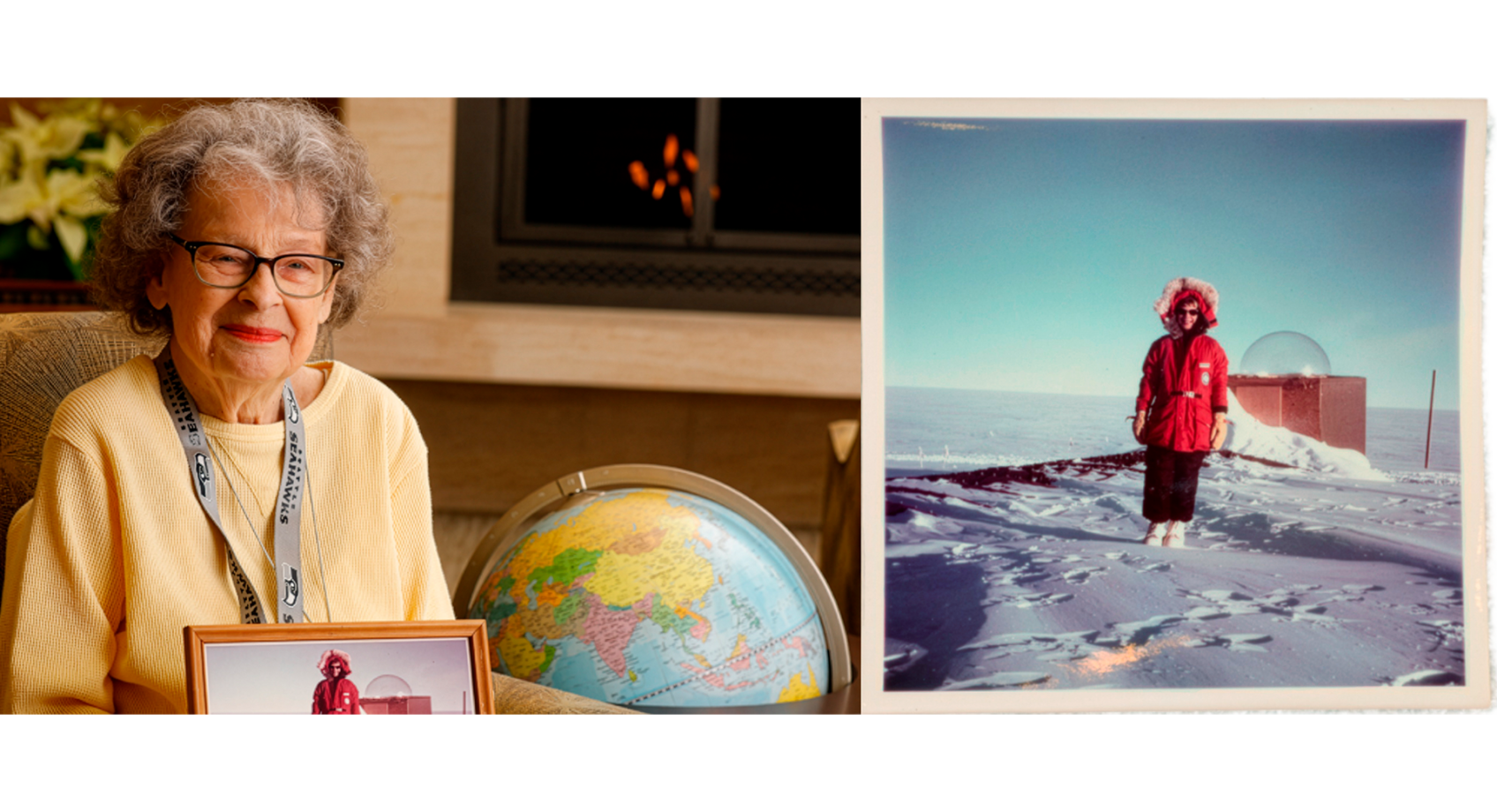








 UW ECE doctoral student Mingfei Chen has received a 2025 Google PhD Fellowship in Machine Perception. This award supports Chen’s pioneering work developing AI systems capable of perceiving and understanding three-dimensional spaces — a capability that could transform robotics, augmented reality, and assistive technologies. Photo by Ryan Hoover / UW ECE[/caption]
UW ECE doctoral student
UW ECE doctoral student Mingfei Chen has received a 2025 Google PhD Fellowship in Machine Perception. This award supports Chen’s pioneering work developing AI systems capable of perceiving and understanding three-dimensional spaces — a capability that could transform robotics, augmented reality, and assistive technologies. Photo by Ryan Hoover / UW ECE[/caption]
UW ECE doctoral student  Google.org is providing over $10 million to support 255 doctoral students like Chen across 35 countries and 12 research domains, committing to a new generation of researchers who understand that accelerating scientific discovery is vital to solving the world’s toughest challenges.[/caption]
Like humans, spatially aware multimodal AI systems use sensing modalities, such as vision, sound, and motion, to build contextual awareness and an understanding of a three-dimensional space. These AI systems also use other modes, such as language and geometry, to enrich their understanding. This technology could help to make the world more accessible and supportive for people, especially for those with disabilities or limited mobility. Potential applications include:
Google.org is providing over $10 million to support 255 doctoral students like Chen across 35 countries and 12 research domains, committing to a new generation of researchers who understand that accelerating scientific discovery is vital to solving the world’s toughest challenges.[/caption]
Like humans, spatially aware multimodal AI systems use sensing modalities, such as vision, sound, and motion, to build contextual awareness and an understanding of a three-dimensional space. These AI systems also use other modes, such as language and geometry, to enrich their understanding. This technology could help to make the world more accessible and supportive for people, especially for those with disabilities or limited mobility. Potential applications include:
 UW ECE Professor Maryam Fazel receives the 2025 Farkas Prize from the INFORMS Optimization Society. The award was presented on October 26 at the INFORMS Annual Meeting in Atlanta, Georgia, by Katya Scheinberg (left), Coca-Cola Foundation Chair and Professor in the H. Milton Stewart School of Industrial and Systems Engineering at Georgia Tech, and Andrea Lodi (right), the Andrew H. and Ann R. Tisch Professor of operations research and information engineering at Cornell University.[/caption]
The University of Washington Department of Electrical & Computer Engineering congratulates Professor
UW ECE Professor Maryam Fazel receives the 2025 Farkas Prize from the INFORMS Optimization Society. The award was presented on October 26 at the INFORMS Annual Meeting in Atlanta, Georgia, by Katya Scheinberg (left), Coca-Cola Foundation Chair and Professor in the H. Milton Stewart School of Industrial and Systems Engineering at Georgia Tech, and Andrea Lodi (right), the Andrew H. and Ann R. Tisch Professor of operations research and information engineering at Cornell University.[/caption]
The University of Washington Department of Electrical & Computer Engineering congratulates Professor  The new UW ECE Entrepreneurial Fellows Program, or UW ECE-EFP, helps translate research into real-world impact. On the left, UW ECE-EFP fellow Jared Nakahara adds droplets into an acoustic levitation prototype he created with his adviser, UW ECE and Allen School Professor Joshua Smith. Together, they co-founded Levity, a startup building acoustic levitators for lab automation. On the right, UW ECE-EFP fellow Sen Zhang holds MultiSensKnit, a sensor-packed knitted sleeve designed for rehabilitation assessment. Zhang created and developed MultiSensKnit with UW ECE Assistant Professor Yiyue Luo.[/caption]
According to the UW’s innovation hub,
The new UW ECE Entrepreneurial Fellows Program, or UW ECE-EFP, helps translate research into real-world impact. On the left, UW ECE-EFP fellow Jared Nakahara adds droplets into an acoustic levitation prototype he created with his adviser, UW ECE and Allen School Professor Joshua Smith. Together, they co-founded Levity, a startup building acoustic levitators for lab automation. On the right, UW ECE-EFP fellow Sen Zhang holds MultiSensKnit, a sensor-packed knitted sleeve designed for rehabilitation assessment. Zhang created and developed MultiSensKnit with UW ECE Assistant Professor Yiyue Luo.[/caption]
According to the UW’s innovation hub,  Levity builds acoustic levitators for automated, contamination-free experiments requiring precise control. The prototype shown above, operated by Nakahara, uses ultrasonic sound waves — well above the threshold of human hearing — to suspend and manipulate droplets and small objects in midair without physical contact.[/caption]
Born and raised in the Seattle area, Jared Nakahara first became interested in engineering when he was in high school, during a summer program at the
Levity builds acoustic levitators for automated, contamination-free experiments requiring precise control. The prototype shown above, operated by Nakahara, uses ultrasonic sound waves — well above the threshold of human hearing — to suspend and manipulate droplets and small objects in midair without physical contact.[/caption]
Born and raised in the Seattle area, Jared Nakahara first became interested in engineering when he was in high school, during a summer program at the  Levity’s tabletop acoustic levitation system is quick to set up and operate, and it can even run remotely. Nakahara demonstrates the prototype while Smith observes — showing how easy this device is to use.[/caption]
What Levity’s acoustic levitation system does could seem like science fiction. The device uses high-frequency sound, well above the threshold of human hearing, to levitate, contain, and manipulate liquids and small objects in midair — all without touching the levitated material. This levitator is a completely enclosed tabletop system that can contain filtered air or inert gases useful for laboratory experimentation, such as helium, or argon. The sound waves it generates create three-dimensional traps, pockets of sound pressure, which provide a contactless, contamination-free way of containing, manipulating, and examining liquids, solids, and living organisms. Because it uses ultrasound, the device is inaudible to humans and safe for people to use as well as for any living organism the device might contain.
“One of the nice things our acoustic levitator can do is lift, manipulate, and contain living organisms without harming them,” Nakahara said. “You can put a living ant or mosquito into this device and examine it with a camera. You can look at the entire specimen while it’s alive, do species identification, and extract much more information than you could from a more conventional platform.”
The advantages of Nakahara and Smith’s levitator as compared to other laboratory automation systems are many. Because it is a completely enclosed, contactless system, it provides an encapsulated environment for experiments. It is capable of mixing liquids and manipulating levitated objects ranging from millimeters to nanometers in diameter— all without touching or contaminating the experimental material. It also can be programmed to automate the manipulation and data collection tasks of laboratory experiments, removing typical and often costly human errors that happen when people pipette liquids and handle materials. The device enables the user to view the reaction progress of their experiment from start to finish as well as examine it in great detail with cameras, spectrometers, or other sensors. This complete encapsulation and tight integration of the experimental procedure allows researchers to gather much more reliable data than what would otherwise be possible when using multiple pieces of equipment. And as a high-precision scientific instrument, this acoustic levitation system can measure the mass of levitated matter down to a nanogram without touching it.
In addition, Levity’s acoustic levitation system is a tabletop device that is easy to set up and use, and it can be run remotely offsite. Nakahara said that accessible, remote operation could open up a world of possibilities for users. For example, the levitator could be set up in underserved or hard-to-reach areas to run fast and accurate on-site tests for diseases. Or researchers could automate and run their experiments from outside the lab, enabling them to do other things while saving time and money. Or several of these acoustic levitators working together could be set up to operate much like a computer server farm does today — providing automated laboratory services for many different users, all from one, compact location.
Levity’s acoustic levitation system could appeal to researchers working in many different types of scientific applications. But for now, Nakahara said he sees Levity’s primary market being researchers who need liquid handling systems for DNA, proteins, and microscopic materials as part of their workflow, for example, when scientists are developing pharmaceuticals or medical diagnostics.
“I think the programmable laboratory space is interesting because we can potentially help to build life-saving pharmaceuticals, treatments for cancer, and personalized medicine as well as other new pharmaceuticals that could be coming to market,” Nakahara said. “If we can help doctors as well as the health-care industry provide faster diagnoses and better treatments, then that’s something of great benefit to everybody.”
Levity’s tabletop acoustic levitation system is quick to set up and operate, and it can even run remotely. Nakahara demonstrates the prototype while Smith observes — showing how easy this device is to use.[/caption]
What Levity’s acoustic levitation system does could seem like science fiction. The device uses high-frequency sound, well above the threshold of human hearing, to levitate, contain, and manipulate liquids and small objects in midair — all without touching the levitated material. This levitator is a completely enclosed tabletop system that can contain filtered air or inert gases useful for laboratory experimentation, such as helium, or argon. The sound waves it generates create three-dimensional traps, pockets of sound pressure, which provide a contactless, contamination-free way of containing, manipulating, and examining liquids, solids, and living organisms. Because it uses ultrasound, the device is inaudible to humans and safe for people to use as well as for any living organism the device might contain.
“One of the nice things our acoustic levitator can do is lift, manipulate, and contain living organisms without harming them,” Nakahara said. “You can put a living ant or mosquito into this device and examine it with a camera. You can look at the entire specimen while it’s alive, do species identification, and extract much more information than you could from a more conventional platform.”
The advantages of Nakahara and Smith’s levitator as compared to other laboratory automation systems are many. Because it is a completely enclosed, contactless system, it provides an encapsulated environment for experiments. It is capable of mixing liquids and manipulating levitated objects ranging from millimeters to nanometers in diameter— all without touching or contaminating the experimental material. It also can be programmed to automate the manipulation and data collection tasks of laboratory experiments, removing typical and often costly human errors that happen when people pipette liquids and handle materials. The device enables the user to view the reaction progress of their experiment from start to finish as well as examine it in great detail with cameras, spectrometers, or other sensors. This complete encapsulation and tight integration of the experimental procedure allows researchers to gather much more reliable data than what would otherwise be possible when using multiple pieces of equipment. And as a high-precision scientific instrument, this acoustic levitation system can measure the mass of levitated matter down to a nanogram without touching it.
In addition, Levity’s acoustic levitation system is a tabletop device that is easy to set up and use, and it can be run remotely offsite. Nakahara said that accessible, remote operation could open up a world of possibilities for users. For example, the levitator could be set up in underserved or hard-to-reach areas to run fast and accurate on-site tests for diseases. Or researchers could automate and run their experiments from outside the lab, enabling them to do other things while saving time and money. Or several of these acoustic levitators working together could be set up to operate much like a computer server farm does today — providing automated laboratory services for many different users, all from one, compact location.
Levity’s acoustic levitation system could appeal to researchers working in many different types of scientific applications. But for now, Nakahara said he sees Levity’s primary market being researchers who need liquid handling systems for DNA, proteins, and microscopic materials as part of their workflow, for example, when scientists are developing pharmaceuticals or medical diagnostics.
“I think the programmable laboratory space is interesting because we can potentially help to build life-saving pharmaceuticals, treatments for cancer, and personalized medicine as well as other new pharmaceuticals that could be coming to market,” Nakahara said. “If we can help doctors as well as the health-care industry provide faster diagnoses and better treatments, then that’s something of great benefit to everybody.”

 UW ECE-EFP fellow Sen Zhang holds MultiSensKnit, a smart textile for rehabilitation assessment that is wearable, comfortable, and washable. MultiSensKnit is a knitted sleeve that contains conductive yarn (the gray strip on the sleeve) and sensors that can pick up EMG and EIT signals as well as measure joint angles while worn by the user. Behind Zhang, on the whiteboard, are calculations that illustrate the working principles behind MultiSensKnit.[/caption]
Sen Zhang grew up in Anyang City in Henan Province, China. As a child, he had several creative interests, and he loved to play. He enjoyed building structures with Legos®, making small, electrical cars and toys, and sewing fabric — all activities that, looking back, served as seeds for his engineering career today.
Both of his parents were medical doctors, and they expected their son to follow in their footsteps after high school. However, Zhang heard the beat of a different drum. When it was time for him to select a university and a course of study, he decided to major in textile engineering instead of pursuing a career in medicine. Zhang attended
UW ECE-EFP fellow Sen Zhang holds MultiSensKnit, a smart textile for rehabilitation assessment that is wearable, comfortable, and washable. MultiSensKnit is a knitted sleeve that contains conductive yarn (the gray strip on the sleeve) and sensors that can pick up EMG and EIT signals as well as measure joint angles while worn by the user. Behind Zhang, on the whiteboard, are calculations that illustrate the working principles behind MultiSensKnit.[/caption]
Sen Zhang grew up in Anyang City in Henan Province, China. As a child, he had several creative interests, and he loved to play. He enjoyed building structures with Legos®, making small, electrical cars and toys, and sewing fabric — all activities that, looking back, served as seeds for his engineering career today.
Both of his parents were medical doctors, and they expected their son to follow in their footsteps after high school. However, Zhang heard the beat of a different drum. When it was time for him to select a university and a course of study, he decided to major in textile engineering instead of pursuing a career in medicine. Zhang attended  Zhang with his adviser, UW ECE Assistant Professor Yiyue Luo, who wears a MultiSensKnit prototype on her arm. Zhang developed MultiSensKnit under Luo’s guidance.[/caption]
With guidance from Luo, Zhang developed
Zhang with his adviser, UW ECE Assistant Professor Yiyue Luo, who wears a MultiSensKnit prototype on her arm. Zhang developed MultiSensKnit under Luo’s guidance.[/caption]
With guidance from Luo, Zhang developed  This close-up of MultiSensKnit shows gray squares of conductive yarn knit into white traditional yarn. The fabric is soft, durable, and washable. Inside the gray squares are EMG and EIT sensors that track muscle and nerve signals and can even map tissues inside the arm.[/caption]
According to the
This close-up of MultiSensKnit shows gray squares of conductive yarn knit into white traditional yarn. The fabric is soft, durable, and washable. Inside the gray squares are EMG and EIT sensors that track muscle and nerve signals and can even map tissues inside the arm.[/caption]
According to the  Applications are now open for two tenure-track Assistant Professor positions at UW ECE. Visit the link below to apply via Interfolio.
Deadline: December 15, 2025
https://www.ece.uw.edu/engage/job-openings/
[post_title] => UW ECE is Hiring!
[post_excerpt] =>
[post_status] => publish
[comment_status] => closed
[ping_status] => closed
[post_password] =>
[post_name] => uw-ece-is-hiring-4
[to_ping] =>
[pinged] =>
[post_modified] => 2025-11-06 11:35:38
[post_modified_gmt] => 2025-11-06 19:35:38
[post_content_filtered] =>
[post_parent] => 0
[guid] => https://www.ece.uw.edu/?post_type=spotlight&p=39127
[menu_order] => 5
[post_type] => spotlight
[post_mime_type] =>
[comment_count] => 0
[filter] => raw
)
[4] => WP_Post Object
(
[ID] => 39108
[post_author] => 27
[post_date] => 2025-11-26 17:46:46
[post_date_gmt] => 2025-11-27 01:46:46
[post_content] =>
Applications are now open for two tenure-track Assistant Professor positions at UW ECE. Visit the link below to apply via Interfolio.
Deadline: December 15, 2025
https://www.ece.uw.edu/engage/job-openings/
[post_title] => UW ECE is Hiring!
[post_excerpt] =>
[post_status] => publish
[comment_status] => closed
[ping_status] => closed
[post_password] =>
[post_name] => uw-ece-is-hiring-4
[to_ping] =>
[pinged] =>
[post_modified] => 2025-11-06 11:35:38
[post_modified_gmt] => 2025-11-06 19:35:38
[post_content_filtered] =>
[post_parent] => 0
[guid] => https://www.ece.uw.edu/?post_type=spotlight&p=39127
[menu_order] => 5
[post_type] => spotlight
[post_mime_type] =>
[comment_count] => 0
[filter] => raw
)
[4] => WP_Post Object
(
[ID] => 39108
[post_author] => 27
[post_date] => 2025-11-26 17:46:46
[post_date_gmt] => 2025-11-27 01:46:46
[post_content] =>  Article by
Article by 
 In high school, Peden discovered her love for science in a chemistry class. Because she was a girl, her high school teachers and counselors discouraged her from going into science as a career, but she was undaunted. After high school, she chose to attend Kansas City Junior College, where she studied chemistry and physics. She enjoyed both subjects, especially physics, but ultimately, she decided to pursue a four-year degree in electrical engineering, thinking it would provide a more viable career path. After two years at Kansas City Junior College, she transferred to the University of Colorado, where in 1947, she graduated with her bachelor’s degree in electrical engineering.
In high school, Peden discovered her love for science in a chemistry class. Because she was a girl, her high school teachers and counselors discouraged her from going into science as a career, but she was undaunted. After high school, she chose to attend Kansas City Junior College, where she studied chemistry and physics. She enjoyed both subjects, especially physics, but ultimately, she decided to pursue a four-year degree in electrical engineering, thinking it would provide a more viable career path. After two years at Kansas City Junior College, she transferred to the University of Colorado, where in 1947, she graduated with her bachelor’s degree in electrical engineering.
 Peden was the first woman to receive her doctoral degree in electrical engineering from Stanford University. Initially starting her graduate studies part-time, she took a leave of absence in 1957 to go back to school full-time at Stanford. She later left SRI and got a job as a research assistant on campus to financially support her studies. The field had evolved by the time Peden returned to graduate school, so she had to work and study extra hours to catch up with her academic peers. Peden completed her master’s degree in 1958 and her doctoral degree in 1962. She conducted research for her doctoral dissertation in the Stanford Microwave Lab, focusing her work on measurement techniques for microwave periodic circuits.
Peden was the first woman to receive her doctoral degree in electrical engineering from Stanford University. Initially starting her graduate studies part-time, she took a leave of absence in 1957 to go back to school full-time at Stanford. She later left SRI and got a job as a research assistant on campus to financially support her studies. The field had evolved by the time Peden returned to graduate school, so she had to work and study extra hours to catch up with her academic peers. Peden completed her master’s degree in 1958 and her doctoral degree in 1962. She conducted research for her doctoral dissertation in the Stanford Microwave Lab, focusing her work on measurement techniques for microwave periodic circuits.
 In 1962, Peden was the first female faculty member to be hired by the UW College of Engineering. After her graduate studies at Stanford, Peden accepted a position as an assistant professor at UW ECE (then UW EE). In 1971, she was promoted to full professor with tenure and remained in the Department until she retired in 1994 as a professor emerita. Her research interests covered several areas, including applied electromagnetics, radio science, antennas, and subsurface remote sensing. She spent close to 30 years at the University. Over her long career, Peden became one of the College’s most well-known and respected engineers. During her time at the UW, Peden served as associate dean in the College from 1973 to 1977 and associate chair in UW ECE from 1983 to 1986. She took a professional leave from 1991 to 1993 to serve as director of the Division of Electrical and Communications Systems at the National Science Foundation. She was known for her pioneering work and leadership in engineering education as well as her research on antennas, radio-wave propagation, and contributions to radio science in the polar regions. In 2018, she received the College’s
In 1962, Peden was the first female faculty member to be hired by the UW College of Engineering. After her graduate studies at Stanford, Peden accepted a position as an assistant professor at UW ECE (then UW EE). In 1971, she was promoted to full professor with tenure and remained in the Department until she retired in 1994 as a professor emerita. Her research interests covered several areas, including applied electromagnetics, radio science, antennas, and subsurface remote sensing. She spent close to 30 years at the University. Over her long career, Peden became one of the College’s most well-known and respected engineers. During her time at the UW, Peden served as associate dean in the College from 1973 to 1977 and associate chair in UW ECE from 1983 to 1986. She took a professional leave from 1991 to 1993 to serve as director of the Division of Electrical and Communications Systems at the National Science Foundation. She was known for her pioneering work and leadership in engineering education as well as her research on antennas, radio-wave propagation, and contributions to radio science in the polar regions. In 2018, she received the College’s  In 1970, Peden became the first American female engineer or scientist to conduct field research as a principal investigator in the interior of the Antarctic continent. She was told by officers in the U.S. Navy, who oversaw Antarctic research logistics at the time, that she could not go to Antarctica without another woman to accompany her. She was also unofficially told before she departed that if she did not complete her experiment and publish the results, another woman wouldn’t be allowed to follow in her footsteps for at least a generation. Peden’s research involved deploying a probe deep into an Antarctic ice sheet to study how very low frequency radio waves traveled through the ice and stone deep below the surface as well as how these waves bounced off the ionosphere, a layer of the earth’s atmosphere, high above. She and her students provided significant information about radio propagation and the polar ionosphere, buried antennas, electromagnetic properties of the ice sheet, and radio propagation over long paths in the polar regions. Her work was later expanded to measure the thickness of the ice sheets and search for structures underneath the surface using a variety of radio wave frequencies. In 1987, she received the U.S. Army’s Outstanding Civilian Service Medal for her research in the Antarctic. The Peden Cliffs in the Antarctic interior were also named in her honor.
In 1970, Peden became the first American female engineer or scientist to conduct field research as a principal investigator in the interior of the Antarctic continent. She was told by officers in the U.S. Navy, who oversaw Antarctic research logistics at the time, that she could not go to Antarctica without another woman to accompany her. She was also unofficially told before she departed that if she did not complete her experiment and publish the results, another woman wouldn’t be allowed to follow in her footsteps for at least a generation. Peden’s research involved deploying a probe deep into an Antarctic ice sheet to study how very low frequency radio waves traveled through the ice and stone deep below the surface as well as how these waves bounced off the ionosphere, a layer of the earth’s atmosphere, high above. She and her students provided significant information about radio propagation and the polar ionosphere, buried antennas, electromagnetic properties of the ice sheet, and radio propagation over long paths in the polar regions. Her work was later expanded to measure the thickness of the ice sheets and search for structures underneath the surface using a variety of radio wave frequencies. In 1987, she received the U.S. Army’s Outstanding Civilian Service Medal for her research in the Antarctic. The Peden Cliffs in the Antarctic interior were also named in her honor.
 In 1989, Peden became the first female president of the Institute of Electrical and Electronics Engineers, or IEEE, Antennas and Propagation Society. She was an IEEE Fellow and was the first woman to serve on the IEEE board of directors. Over the years, she held a number of positions in the IEEE, including Vice President of Educational Activities. Peden was quite active in other professional organizations as well. She was a member of the Society of Women Engineers, helped to form the collegiate section of the SWE at the UW, and served as its faculty adviser. She also participated in and was president of the Pacific Northwest Section of the SWE. She served on several national advisory committees, including the advisory committee to the Stanford University School of Engineering. She also served as board member and chair of several science and engineering associations, including the American Association for the Advancement of Science. She was active in ABET, chaired the organization’s Engineering Accreditation Commission and served on the ABET board of directors.
In 1989, Peden became the first female president of the Institute of Electrical and Electronics Engineers, or IEEE, Antennas and Propagation Society. She was an IEEE Fellow and was the first woman to serve on the IEEE board of directors. Over the years, she held a number of positions in the IEEE, including Vice President of Educational Activities. Peden was quite active in other professional organizations as well. She was a member of the Society of Women Engineers, helped to form the collegiate section of the SWE at the UW, and served as its faculty adviser. She also participated in and was president of the Pacific Northwest Section of the SWE. She served on several national advisory committees, including the advisory committee to the Stanford University School of Engineering. She also served as board member and chair of several science and engineering associations, including the American Association for the Advancement of Science. She was active in ABET, chaired the organization’s Engineering Accreditation Commission and served on the ABET board of directors.
 Peden received many prestigious awards and honors throughout her career, including in 1993, when she became the first of only five UW ECE faculty ever admitted into the National Academy of Engineering. That same year, she was named the National Science Foundation’s Federal Engineer of the Year and she was inducted into the American Society for Engineering Education’s Engineering Educators Hall of Fame. She was a Fellow of the AAAS, ASEE, ABET, and the SWE. She received the SWE Achievement Award in 1973. IEEE honored her with their Distinguished Achievement Award, the Centennial Medal, in 1984; the Haraden Pratt Award in 1988; and the Third Millennium Medal in 2000. She also received the Society’s “Man of the Year” award, which through its name alone, illustrated the sorts of obstacles she faced in her career.
Peden received many prestigious awards and honors throughout her career, including in 1993, when she became the first of only five UW ECE faculty ever admitted into the National Academy of Engineering. That same year, she was named the National Science Foundation’s Federal Engineer of the Year and she was inducted into the American Society for Engineering Education’s Engineering Educators Hall of Fame. She was a Fellow of the AAAS, ASEE, ABET, and the SWE. She received the SWE Achievement Award in 1973. IEEE honored her with their Distinguished Achievement Award, the Centennial Medal, in 1984; the Haraden Pratt Award in 1988; and the Third Millennium Medal in 2000. She also received the Society’s “Man of the Year” award, which through its name alone, illustrated the sorts of obstacles she faced in her career.
 In addition to her teaching and research, Peden was an outspoken advocate for women in science, technology, engineering, and mathematics. She was known for helping others succeed by serving as a mentor and role model, and for working to expand pre-college engineering education for all. She fought for equal treatment for women, including through conducting salary surveys at the UW. Through her tireless efforts, Peden opened doors for female engineers to succeed on the UW campus. In 2006, the
In addition to her teaching and research, Peden was an outspoken advocate for women in science, technology, engineering, and mathematics. She was known for helping others succeed by serving as a mentor and role model, and for working to expand pre-college engineering education for all. She fought for equal treatment for women, including through conducting salary surveys at the UW. Through her tireless efforts, Peden opened doors for female engineers to succeed on the UW campus. In 2006, the  The Institute for Foundations of Data Science, led by UW ECE Professor Maryam Fazel, held the 2025 IFDS Workshop on Theoretical Foundations of Applied AI in August on the UW campus. The event brought AI and machine learning experts together from across the nation to discuss and explore the mathematical, statistical, and algorithmic underpinnings of modern AI systems — advancing theory in an effort to better understand and improve the trustworthiness, reliability, and robustness of AI technology. Shown above: Aaditya Ramdas, a professor from Carnegie Mellon University, giving a talk at the workshop. Photo by Ryan Hoover / UW ECE[/caption]
Artificial intelligence has quickly become an indispensable part of modern life. Today, AI systems support search engines, streaming services, social media, and various online tools and products over a wide range of devices. AI also enables behind-the-scenes automation in a vast array of fields, including security, finance, transportation, and health care. With such widespread use taking place, it’s fair to say that the world is now in the early stages of running on and reaping the benefits of AI and related technologies.
But alongside these benefits, people are beginning to deal with serious problems and challenges that come with this powerful technology. For example, online misinformation and disinformation has long been a problem for societies around the world, and AI is turning up the volume on these issues by making it easy to produce
The Institute for Foundations of Data Science, led by UW ECE Professor Maryam Fazel, held the 2025 IFDS Workshop on Theoretical Foundations of Applied AI in August on the UW campus. The event brought AI and machine learning experts together from across the nation to discuss and explore the mathematical, statistical, and algorithmic underpinnings of modern AI systems — advancing theory in an effort to better understand and improve the trustworthiness, reliability, and robustness of AI technology. Shown above: Aaditya Ramdas, a professor from Carnegie Mellon University, giving a talk at the workshop. Photo by Ryan Hoover / UW ECE[/caption]
Artificial intelligence has quickly become an indispensable part of modern life. Today, AI systems support search engines, streaming services, social media, and various online tools and products over a wide range of devices. AI also enables behind-the-scenes automation in a vast array of fields, including security, finance, transportation, and health care. With such widespread use taking place, it’s fair to say that the world is now in the early stages of running on and reaping the benefits of AI and related technologies.
But alongside these benefits, people are beginning to deal with serious problems and challenges that come with this powerful technology. For example, online misinformation and disinformation has long been a problem for societies around the world, and AI is turning up the volume on these issues by making it easy to produce  UW ECE Professor Maryam Fazel is an international leader in the study of artificial intelligence and machine learning. In addition to directing the Institute for Foundations of Data Science and co-organizing the IFDS workshop described in this article, Fazel organizes and speaks at other notable conferences, workshops, and events that bring researchers together worldwide, such as the 2025 International Conference on Machine Learning (see the ICML description and link below). Photo by Ryan Hoover / UW ECE[/caption]
“The IFDS supports cross-collaborations between faculty and student researchers from many different departments at several universities. We have collaborative projects in progress as well as published papers and talks that tackle the challenges of modern AI,” said UW ECE Moorthy Family Professor
UW ECE Professor Maryam Fazel is an international leader in the study of artificial intelligence and machine learning. In addition to directing the Institute for Foundations of Data Science and co-organizing the IFDS workshop described in this article, Fazel organizes and speaks at other notable conferences, workshops, and events that bring researchers together worldwide, such as the 2025 International Conference on Machine Learning (see the ICML description and link below). Photo by Ryan Hoover / UW ECE[/caption]
“The IFDS supports cross-collaborations between faculty and student researchers from many different departments at several universities. We have collaborative projects in progress as well as published papers and talks that tackle the challenges of modern AI,” said UW ECE Moorthy Family Professor  Participants in the 2025 IFDS Workshop on Theoretical Foundations of Applied AI at the Bill & Melinda Gates Center for Computer Science & Engineering on the UW campus. Photo provided by Professor Maryam Fazel.[/caption]
The IFDS workshop brought together mathematicians, statisticians, computer scientists, and other AI and machine learning experts from across the country. One of the main topics speakers and attendees discussed was how algorithms that underpin AI learn from data and how that learning process could be better understood and improved. AI models used for a variety of applications, including large language models, such as
Participants in the 2025 IFDS Workshop on Theoretical Foundations of Applied AI at the Bill & Melinda Gates Center for Computer Science & Engineering on the UW campus. Photo provided by Professor Maryam Fazel.[/caption]
The IFDS workshop brought together mathematicians, statisticians, computer scientists, and other AI and machine learning experts from across the country. One of the main topics speakers and attendees discussed was how algorithms that underpin AI learn from data and how that learning process could be better understood and improved. AI models used for a variety of applications, including large language models, such as 
